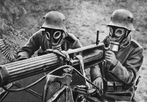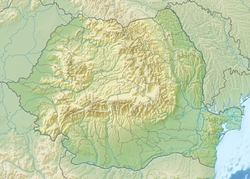World War I
| World War I | |||||||||
|---|---|---|---|---|---|---|---|---|---|
| |||||||||
| |||||||||
| Belligerents | |||||||||
Allied Powers:
|
Central Powers:
| ||||||||
| Commanders and leaders | |||||||||
| Main Allied leaders: | Main Central leaders: | ||||||||
| Casualties and losses | |||||||||
|
| ||||||||
World War I[j]or theFirst World War(28 July 1914 – 11 November 1918) was aglobal conflictbetween two coalitions: theAlliesand theCentral Powers.Fighting took place throughoutEurope,theMiddle East,Africa,thePacific,and parts ofAsia.One of thedeadliest wars in history,it resulted in an estimated 9 million soldiers dead and 23 million wounded, plus up to 8 million civilian deaths from numerous causes includinggenocide.The movement of large numbers of troops and civilians during the war was a major factor in spreading the 1918Spanish flupandemic.
Increasing diplomatic tensions between the European great powers reached abreaking pointon 28 June 1914, when aBosnian SerbnamedGavrilo Principassassinated Archduke Franz Ferdinand,heir to theAustro-Hungarianthrone.Austria-HungaryheldSerbiaresponsible, and declared war on 28 July.Russiacame to Serbia's defence, and by 4 August,Germany,France,andBritainwere drawn into the war, with theOttoman Empirejoining in November of the same year.Germany's strategy in 1914was to first defeat France, then transfer forces to the Russian front. However, thisfailed,and by the end of 1914, theWestern Frontconsisted of a continuous line oftrenchesstretching from theEnglish ChanneltoSwitzerland.TheEastern Frontwas more dynamic, but neither side could gain a decisive advantage, despite costly offensives. As the war expanded to more fronts,Bulgaria,Italy,Romania,Greeceand others joined in from 1915 onward.
In early 1917, theUnited States entered the waron the Allies' side, and later the same year, theBolsheviksseized power in the RussianOctober Revolution,makingpeacewith the Central Powers in early 1918. Germany launched anoffensivein the west in March 1918, and despite initial successes, it left theGerman Armyexhausted and demoralised. A successful Alliedcounter-offensivelater that year caused a collapse of the German front line. By the end of 1918, Bulgaria, theOttoman Empireand Austria-Hungary agreed to armistices with the Allies, leaving Germany isolated. Facingrevolutionat home and with his army on the verge of mutiny,Kaiser WilhelmIIabdicated on 9 November.
The fighting ended with theArmistice of 11 November 1918,while the subsequentParis Peace Conferenceimposed various settlements on the defeated powers, notably theTreaty of Versailles.The dissolution of the Russian, German, Austro-Hungarian, and Ottoman Empires resulted in the creation of new independent states, includingPoland,Finland,Czechoslovakia,andYugoslavia.The inability to managepostwar instabilitycontributedto the outbreak ofWorld War IIin September 1939.
Names
The first recorded use of the termFirst World Warwas in September 1914 by German biologist and philosopherErnst Haeckelwho stated, "There is no doubt that the course and character of the feared 'European War'... will become the first world war in the full sense of the word."[1]It was later used as a title for his 1920 memoirs by Lt-Col.Charles à Court Repington.[citation needed]
BeforeWorld War II,the events of 1914–1918 were generally known as theGreat Waror simply theWorld War.[2]In August 1914, the magazineThe Independentwrote "This is the Great War. It names itself".[3]In October 1914, the Canadian magazineMaclean'ssimilarly wrote, "Some wars name themselves. This is the Great War."[4]Contemporary Europeans also referred to it as "the war to end war"and it was also described as" the war to end all wars "due to their perception of its unparalleled scale, devastation, and loss of life.[5]
Background
Political and military alliances
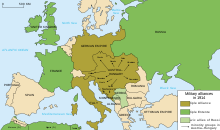
For much of the 19th century, the major European powers maintained a tenuousbalance of power,known as theConcert of Europe.[6]After 1848, this was challenged by Britain's withdrawal into so-calledsplendid isolation,thedecline of the Ottoman Empire,New Imperialism,and the rise ofPrussiaunderOtto von Bismarck.The 1866Austro-Prussian Warestablished Prussianhegemonyin German states, while victory in the 1870–1871Franco-Prussian Warallowed Bismarck toconsolidateaGerman Empireunder Prussian leadership. Post 1871, the primary aim of French policy was toavengethis defeat,[7]but by the early 1890s, this had switched to the expansion of theFrench colonial empire.[8]
In 1873, Bismarck negotiated theLeague of the Three Emperors,which includedAustria-Hungary,Russiaand Germany. After the 1877–1878Russo-Turkish War,the League was dissolved due to Austrian concerns over the expansion of Russian influence in theBalkans,an area they considered to be of vital strategic interest.Germanyand Austria-Hungary then formed the 1879Dual Alliance,which became theTriple Alliancewhen Italy joined in 1882.[9]For Bismarck, the purpose of these agreements was to isolate France by ensuring the three Empires resolve any disputes between themselves; when this was threatened in 1880 by British and French attempts to negotiate directly with Russia, he reformed the League in 1881, which was renewed in 1883 and 1885. After this expired in 1887, Bismarck set up theReinsurance Treaty,a secret agreement between Germany and Russia to remain neutral if either were attacked by France or Austria-Hungary.[10]

For Bismarck, peace with Russia was the foundation of German foreign policy but in 1890, he was forced to retire byWilhelm II.The latter was persuaded not to renew the Reinsurance Treaty by his newChancellor,Leo von Caprivi.[11]This gave France an opening to agree theFranco-Russian Alliancein 1894, which was then followed by the 1904Entente Cordialewith Britain. TheTriple Ententewas completed by the 1907Anglo-Russian Convention.While not formal alliances, by settlinglong-standing colonial disputes in Asiaand Africa, British support for France or Russia in any future conflict now became a possibility.[12]This was accentuated by British and Russian support for France against Germany during the 1911Agadir Crisis.[13]
Arms race
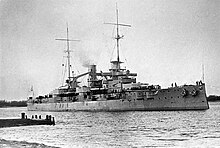
German economic and industrial strength continued to expand rapidly post 1871. Backed by Wilhelm II, AdmiralAlfred von Tirpitzsought to use this growth to build anImperial German Navy,that could compete with the BritishRoyal Navy.[14]This policy was based on the work of by US naval authorAlfred Thayer Mahan,who argued that possession of ablue-water navywas vital for global power projection; Tirpitz had his books translated into German, while Wilhelm made them required reading for his advisors and senior military personnel.[15]
However, it was also an emotional decision, driven by Wilhelm's simultaneous admiration for the Royal Navy and desire to surpass it. Bismarck thought that the British would not interfere in Europe, as long as its maritime supremacy remained secure, but his dismissal in 1890 led to a change in policy and anAnglo-German naval arms racebegan.[16]Despite the vast sums spent by Tirpitz, the launch ofHMSDreadnoughtin 1906 gave the British a technological advantage over their German rivals.[14]Ultimately, the race diverted huge resources into creating a German navy large enough to antagonise Britain, but not defeat it; in 1911, ChancellorTheobald von Bethmann Hollwegacknowledged defeat, leading to theRüstungswendeor 'armaments turning point', when he switched expenditure from the navy to the army.[17]
This decision was not driven by a reduction in political tensions but by German concern over Russia's quick recovery from its defeat in theRusso-Japanese Warand subsequent1905 Russian Revolutionthat same year. Economic reforms, backed by French funding, led to a significant post-1908 expansion of railways and transportation infrastructure, particularly in its western border regions.[18]Since Germany and Austria-Hungary relied on faster mobilisation to compensate for their numerical inferiority compared toRussia,the threat posed by the closing of this gap was more important than competing with the Royal Navy. After Germany expanded its standing army by 170,000 troops in 1913, France extended compulsory military service from two to three years; similar measures were taken by theBalkan powersand Italy, which led to increased expenditure by theOttomansand Austria-Hungary. Absolute figures are difficult to calculate due to differences in categorising expenditure since they often omit civilian infrastructure projects like railways which also had logistical importance and military use. It is known, however, that from 1908 to 1913, military spending by the six major European powers increased by over 50% in real terms.[19]
Conflicts in the Balkans

The years before 1914 were marked by a series of crises in the Balkans, as other powers sought to benefit from the Ottoman decline. WhilePan-SlavicandOrthodoxRussia considered itself the protector ofSerbiaand otherSlavstates, they preferred the strategically vitalBosporusstraits to be controlled by a weak Ottoman government, rather than an ambitious Slav power likeBulgaria.Russia had ambitions in northeasternAnatoliawhile its clients had overlapping claims in the Balkans. These competing interests divided Russian policy-makers and added to regional instability.[20]
Austrian statesmen viewed the Balkans as essential for the continued existence of their Empire and saw Serbian expansion as a direct threat. The 1908–1909Bosnian Crisisbegan when Austria annexed the former Ottoman territory ofBosnia and Herzegovina,which ithad occupiedsince 1878. Timed to coincide with theBulgarian Declaration of Independencefrom the Ottoman Empire, this unilateral action was denounced by the European powers, but accepted as there was no consensus on how to resolve the situation. Some historians see this as a significant escalation, ending any chance of Austria cooperating with Russia in the Balkans, while also damaging diplomatic relations between Serbia and Italy, both of whom had their expansionist ambitions in the region.[21]
Tensions increased after the 1911–1912Italo-Turkish Wardemonstrated Ottoman weakness and led to the formation of theBalkan League,an alliance of Serbia, Bulgaria,Montenegro,andGreece.[22]The League quickly overran most of the Ottomans' territory in the Balkans during the 1912–1913First Balkan War,much to the surprise of outside observers.[23]The Serbian capture of ports on theAdriaticresulted in partial Austrian mobilisation, starting on 21 November 1912, including units along the Russian border inGalicia.In a meeting the next day, theRussian governmentdecided not to mobilise in response, unwilling to precipitate a war for which they were not as of yet prepared to handle.[24]
The Great Powers sought to re-assert control through the 1913Treaty of London,which had created an independentAlbaniawhile enlarging the territories of Bulgaria, Serbia, Montenegro and Greece. However, disputes between the victors sparked the 33-daySecond Balkan War,when Bulgaria attacked Serbia and Greece on 16 June 1913; it was defeated, losing most ofMacedoniato Serbia and Greece, andSouthern Dobrujato Romania.[25]The result was that even countries which benefited from the Balkan Wars, such as Serbia and Greece, felt cheated of their "rightful gains", while for Austria it demonstrated the apparent indifference with which other powers viewed their concerns, including Germany.[26]This complex mix of resentment, nationalism and insecurity helps explain why the pre-1914 Balkans became known as the "powder keg of Europe".[27][failed verification]
Prelude
Sarajevo assassination

In the summer of 1914, the sovereigns of Europe were woven together by treaties, alliances, as well as secret agreements. TheTriple Alliance (1882)encompassed the German Empire,Austria,and Italy.[30]
On 28 June 1914,Archduke Franz Ferdinand of Austria,heir presumptive to EmperorFranz Joseph I of Austria,visitedSarajevo,the capital of the recently annexedBosnia and Herzegovina.Cvjetko Popović,Gavrilo Princip,Nedeljko Čabrinović,Trifko Grabež,andVaso Čubrilović(Bosnian Serbs) andMuhamed Mehmedbašić(from theBosniakscommunity),[31]from the movement known asYoung Bosnia,took up positions along the route taken by the Archduke's motorcade, to assassinate him. Supplied with arms by extremists within the SerbianBlack Handintelligence organisation, they hoped his death would free Bosnia from Austrian rule, although there was little agreement on what would replace it.[32]
Nedeljko Čabrinovićthrew agrenadeat the Archduke's car and injured two of his aides, who were taken to hospital while the convoy carried on. The other assassins were also unsuccessful but, an hour later, as Ferdinand was returning from visiting the injured officers, his car took a wrong turn into a street whereGavrilo Principwas standing. He fired two pistol shots, fatally wounding Ferdinand and his wifeSophie.[33]Although Emperor Franz Joseph was shocked by the incident, political and personal differences meant the two men were not close; allegedly, his first reported comment was "A higher power has re-established the order which I, alas, could not preserve".[34]
According to historianZbyněk Zeman,inVienna"the event almost failed to make any impression whatsoever. On 28 and 29 June, the crowds listened to music and drank wine, as if nothing had happened."[35]Nevertheless, the impact of the murder of the heir to the throne was significant, and has been described by historianChristopher Clarkas a "9/11 effect,a terrorist event charged with historic meaning, transforming the political chemistry in Vienna ".[36]
Expansion of violence in Bosnia and Herzegovina

Austro-Hungarian authorities encouraged subsequentanti-Serb riots in Sarajevo,in whichBosnian CroatsandBosniakskilled twoBosnian Serbsand damaged numerous Serb-owned buildings.[37][38]Violent actions against ethnic Serbs were also organised outside Sarajevo, in other cities in Austro-Hungarian-controlled Bosnia and Herzegovina, Croatia and Slovenia. Austro-Hungarian authorities in Bosnia and Herzegovina imprisoned and extradited approximately 5,500 prominent Serbs, 700 to 2,200 of whom died in prison. A further 460 Serbs were sentenced to death. A predominantly Bosniak special militia known as theSchutzkorpswas established, and carried out the persecution of Serbs.[39][40][41][42]
July Crisis
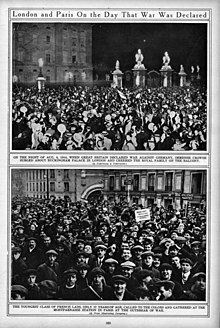
The assassination initiated theJuly Crisis,a month of diplomatic manoeuvring between Austria-Hungary, Germany, Russia, France and Britain. Believing that Serbian intelligence helped organise Franz Ferdinand's murder, Austrian officials wanted to use the opportunity to end their interference in Bosnia and saw war as the best way of achieving this.[43]However, theForeign Ministryhad no solid proof of Serbian involvement and a dossier used to make its case contained multiple errors.[44]On 23July, Austria delivered anultimatumto Serbia, listing ten demands made intentionally unacceptable to provide an excuse for starting hostilities.[45]
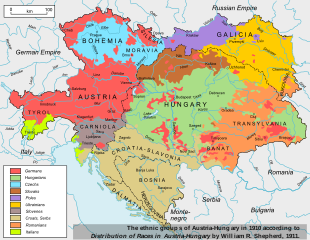
Serbia ordered generalmobilizationon 25July, but accepted all the terms, except for those empowering Austrian representatives to suppress "subversive elements" inside Serbia, and take part in the investigation and trial of Serbians linked to the assassination.[46][47]Claiming this amounted to rejection, Austria broke off diplomatic relations and ordered partial mobilisation the next day; on 28 July, they declared war on Serbia and began shellingBelgrade.Having initiated war preparations on 25 July, Russia now ordered general mobilization in support of Serbia on 30th.[48]
Anxious to ensure backing from theSPDpolitical opposition by presenting Russia as the aggressor, German Chancellor Bethmann Hollweg delayed the commencement of war preparations until 31 July.[49]That afternoon, the Russian government were handed a note requiring them to "cease all war measures against Germany and Austria-Hungary" within 12 hours.[50]A further German demand for neutrality was refused by the French who ordered general mobilization but delayed declaring war.[51]TheGerman General Staffhad long assumed they faced a war on two fronts; theSchlieffen Planenvisaged using 80% of the army to defeat France, then switch to Russia. Since this required them to move quickly, mobilization orders were issued that afternoon.[52]
At a meeting on 29 July, the British cabinet had narrowly decided its obligations to Belgium under the 1839Treaty of Londondid not require it to oppose a German invasion with military force. However, this was largely driven by Prime MinisterAsquith's desire to maintain unity; he and his senior Cabinet ministers were already committed to supporting France, the Royal Navy had been mobilised, and public opinion was strongly in favour of intervention.[53]On 31 July, Britain sent notes to Germany and France, asking them to respect Belgian neutrality; France pledged to do so, but Germany did not reply.[54]
Once the German ultimatum to Russia expired on the morning of 1 August, the two countries were at war. Later the same day, Wilhelm was informed by his ambassador in London,Prince Lichnowsky,that Britain would remain neutral if France was not attacked, and might not intervene at all given the ongoingHome Rule Crisisin Ireland.[55]Jubilant at this news, he ordered GeneralMoltke,the German chief of staff, to "march the whole of the... army to the East ". This allegedly brought Moltke to the verge of a nervous breakdown, before Lichnowsky realized he was mistaken. Once Wilhelm received a telegram fromGeorge V,it confirmed there had been a misunderstanding, and he told Moltke, "Now do what you want."[56]
Aware of German plans to attack through Belgium, French Commander-in-ChiefJoseph Joffreasked his government for permission to cross the border and pre-empt such a move. To avoid violating Belgian neutrality, he was told any advance could come only after a German invasion.[57]Instead, the French cabinet ordered its Army to withdraw 10 km behind the German frontier, to avoid any incident which might provoke the war. On 2 August,Germany occupied Luxembourgand exchanged fire with French units when German patrols entered French territory; on 3August, they declared war on France and demanded free passage across Belgium, which was refused. Early on the morning of 4August, the Germans invaded, andAlbert I of Belgiumcalled for assistance under theTreaty of London.[58][59]Britain sent Germany an ultimatum demanding they withdraw from Belgium; when this expired at midnight, without a response, the two empires were at war.[60]
Progress of the war
Opening hostilities
Confusion among the Central Powers
The strategy of the Central Powers suffered from miscommunication. Germany promised to support Austria-Hungary's invasion of Serbia, but interpretations of what this meant differed. Previously tested deployment plans had been replaced early in 1914, but those had never been tested in exercises. Austro-Hungarian leaders believed Germany would cover its northern flank against Russia.[61]
Serbian campaign

Beginning on 12 August, the Austrians and Serbs clashed at the battles of theCerandKolubara;over the next two weeks, Austrian attacks were repulsed with heavy losses, dashing their hopes of a swift victory and marking the first major Allied victories of the war. As a result, Austria had to keep sizeable forces on the Serbian front, weakening their efforts against Russia.[62]Serbia's victory against Austria-Hungary in the 1914 invasion has been called one of the major upset victories of the twentieth century.[63]In spring 1915, the campaign saw the first use ofanti-aircraft warfareafter an Austrian plane was shot down withground-to-airfire, as well as the firstmedical evacuationby the Serbian army in autumn 1915.[64][65]
German offensive in Belgium and France

Upon mobilisation, 80% of theGerman Armywas located on the Western Front, with the remainder acting as a screening force in the East; officially titledAufmarsch II West,it is better known as theSchlieffen Planafter its creator,Alfred von Schlieffen,head of theGerman General Stafffrom 1891 to 1906. Rather than a direct attack across their shared frontier, the German right wing would sweep through theNetherlandsandBelgium,then swing south, encircling Paris and trapping the French army against the Swiss border. Schlieffen estimated that this would take six weeks, after which the German army would transfer to the East and defeat the Russians.[66]
The plan was substantially modified by his successor,Helmuth von Moltke the Younger.Under Schlieffen, 85% of German forces in the west were assigned to the right wing, with the remainder holding along the frontier. By keeping his left-wing deliberately weak, he hoped to lure the French into an offensive into the "lost provinces" ofAlsace-Lorraine,which was the strategy envisaged by theirPlan XVII.[66]However, Moltke grew concerned that the French might push too hard on his left flank and as the German Army increased in size from 1908 to 1914, he changed the allocation of forces between the two wings from 85:15 to 70:30.[67]He also considered Dutch neutrality essential for German trade and cancelled the incursion into the Netherlands, which meant any delays in Belgium threatened the viability of the plan.[68]HistorianRichard Holmesargues that these changes meant the right wing was not strong enough to achieve decisive success and thus led to unrealistic goals and timings.[69]
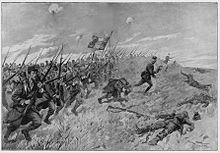
The initial German advance in the West was very successful and by the end of August, the Allied left, which included theBritish Expeditionary Force(BEF), was infull retreat.At the same time, the French offensive in Alsace-Lorraine was a disastrous failure, with casualties exceeding 260,000, including 27,000 killed on 22 August during theBattle of the Frontiers.[70]German planning provided broad strategic instructions while allowing army commanders considerable freedom in carrying them out at the front; this worked well in 1866 and 1870 but in 1914,von Kluckused this freedom to disobey orders, opening a gap between the German armies as they closed on Paris.[71]The French army, reinforced by the British expeditionary corps, seized this opportunity to counter-attack and pushed the German army 40 to 80 km back. Both armies were then so exhausted that no decisive move could be implemented, so they settled in trenches, with the vain hope of breaking through as soon as they could build local superiority.
In 1911, the RussianStavkaagreed with the French to attack Germany within fifteen days of mobilisation, ten days before the Germans had anticipated, although it meant the two Russian armies that enteredEast Prussiaon 17 August did so without many of their support elements.[72]
By the end of 1914, German troops held strong defensive positions inside France, controlled the bulk of France's domestic coalfields, and inflicted 230,000 more casualties than it lost itself. However, communications problems, combined with questionable command decisions, cost Germany the chance of a decisive outcome, while it had failed to achieve the primary objective of avoiding a long, two-front war.[73]As was apparent to several German leaders, this amounted to a strategic defeat; shortly after theFirst Battle of the Marne,Crown Prince Wilhelmtold an American reporter "We have lost the war. It will go on for a long time but lost it is already."[74]
Asia and the Pacific

On 30 August 1914, New Zealandoccupied German Samoa,now the independent state ofSamoa.On 11 September, theAustralian Naval and Military Expeditionary Forcelanded on the island ofNew Britain,then part ofGerman New Guinea.On 28 October, the German cruiserSMSEmdensank theRussian cruiserZhemchugin theBattle of Penang.Japan declared war on Germany before seizing territories in the Pacific, which later became theSouth Seas Mandate,as well as GermanTreaty portson the ChineseShandongpeninsula atTsingtao.After Vienna refused to withdraw its cruiserSMSKaiserin Elisabethfrom Tsingtao, Japan declared war on Austria-Hungary as well, and the ship was sunk at Tsingtao in November 1914.[75]Within a few months, Allied forces had seized all German territories in the Pacific, leaving only isolated commerce raiders and a few holdouts in New Guinea.[76][77]
African campaigns
Some of the first clashes of the war involved British, French, and German colonial forces in Africa. On 6–7 August, French and British troops invaded the German protectorates ofTogolandandKamerun.On 10 August, German forces inSouth-West Africaattacked South Africa; sporadic and fierce fighting continued for the rest of the war. The German colonial forces inGerman East Africa,led by ColonelPaul von Lettow-Vorbeck,fought aguerrilla warfarecampaign during World WarI and only surrendered two weeks after the armistice took effect in Europe.[78]
Indian support for the Allies
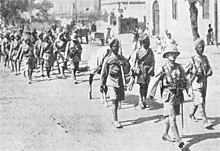
Before the war, Germany had attempted to use Indian nationalism and pan-Islamism to its advantage, a policy continued post-1914 byinstigating uprisings in India,while theNiedermayer–Hentig Expeditionurged Afghanistan to join the war on the side of Central Powers. However, contrary to British fears of a revolt in India, the outbreak of the war saw a reduction in nationalist activity.[79][80]This was largely because leaders from theIndian National Congressand other groups believed support for the British war effort would hastenIndian Home Rule,a promise allegedly made explicit in 1917 byEdwin Montagu,theSecretary of State for India.[81]
In 1914, theBritish Indian Armywas larger than the British Army itself, and between 1914 and 1918 an estimated 1.3 million Indian soldiers and labourers served in Europe, Africa, and the Middle East, while theGovernment of Indiaand theirprincely alliessupplied large quantities of food, money, and ammunition. In all, 140,000 soldiers served on the Western Front and nearly 700,000 in the Middle East, with 47,746 killed and 65,126 wounded.[82]
The suffering engendered by the war, as well as the failure of the British government to grant self-government to India after the end of hostilities, bred disillusionment, resulting inthe campaign for full independenceled byMahatma Gandhi.[83]
Western Front 1914 to 1916
Trench warfare begins

Pre-war military tactics that had emphasised open warfare and the individual rifleman proved obsolete when confronted with conditions prevailing in 1914. Technological advances allowed the creation of strong defensive systems largely impervious to massed infantry advances, such asbarbed wire,machine guns and above all far more powerfulartillery,which dominated the battlefield and made crossing open ground extremely difficult.[84]Both sides struggled to develop tactics for breaching entrenched positions without suffering heavy casualties. In time, however, technology enabled the production of new offensive weapons, such asgas warfareand thetank.[85]
After theFirst Battle of the Marnein September 1914, Allied and German forces unsuccessfully tried to outflank each other, a series of manoeuvres later known as the "Race to the Sea".By the end of 1914, the opposing forces confronted each other along an uninterrupted line of entrenched positions from theChannelto the Swiss border.[86]Since the Germans were normally able to choose where to stand, they generally held the high ground, while their trenches tended to be better built; those constructed by the French and English were initially considered "temporary", only needed until an offensive would destroy the German defences.[87]Both sides tried to break the stalemate using scientific and technological advances. On 22 April 1915, at theSecond Battle of Ypres,the Germans (violating theHague Convention) usedchlorinegas for the first time on the Western Front. Several types of gas soon became widely used by both sides and though it never proved a decisive, battle-winning weapon, it became one of the most feared and best-remembered horrors of the war.[88][89]
Continuation of trench warfare
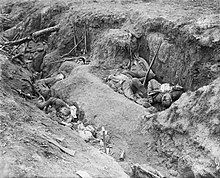
In February 1916, the Germans attacked French defensive positions at theBattle of Verdun,lasting until December 1916. The Germans made initial gains before French counter-attacks returned matters to near their starting point. Casualties were greater for the French, but the Germans bled heavily as well, with anywhere from 700,000[90]to 975,000[91]casualties suffered between the two combatants. Verdun became a symbol of French determination and self-sacrifice.[92]
TheBattle of the Sommewas an Anglo-French offensive from July to November 1916. Theopening dayon 1 July 1916 was the bloodiest single day in the history of theBritish Army,which suffered 57,500 casualties, including 19,200 dead. As a whole, the Somme offensive led to an estimated 420,000 British casualties, along with 200,000 French and 500,000 Germans.[93]Gunfire was not the only cause of death; the diseases that emerged in the trenches were a major killer on both sides. The living conditions led to disease and infection, such astrench foot,lice,typhus,trench fever,and the 'Spanish flu'.[94]
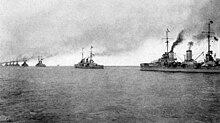
At the start of the war, Germancruiserswere scattered across the globe, some of which were subsequently used to attack Alliedmerchant shipping.These were systematically hunted down by the Royal Navy, though not before causing considerable damage. One of the most successful was theSMSEmden,part of the GermanEast Asia Squadronstationed at Qingdao, which seized or sank 15 merchantmen, as well as a Russian cruiser and a French destroyer. Most of the squadron was returning to Germany when it sank two British armoured cruisers at theBattle of Coronelin November 1914, before being virtually destroyed at theBattle of the Falkland Islandsin December. TheSMSDresdenescaped with a few auxiliaries, but after theBattle of Más a Tierra,these too were either destroyed or interned.[95]
Soon after the outbreak of hostilities, Britain began a navalblockade of Germany.This proved effective in cutting off vital military and civilian supplies, though it violated accepted international law.[96]Britain also mined international waters which closed off entire sections of the ocean, even to neutral ships.[97]Since there was limited response to this tactic of the British, Germany expected a similar response to its unrestricted submarine warfare.[98]
TheBattle of Jutland[l]in May/June 1916 was the only full-scale clash of battleships during the war, and one of the largest in history. The clash was indecisive, though the Germans inflicted more damage than they received, since thereafter the bulk of the GermanHigh Seas Fleetwas confined to port.[99]

GermanU-boatsattempted to cut the supply lines between North America and Britain.[100]The nature ofsubmarine warfaremeant that attacks often came without warning, giving the crews of the merchant ships little hope of survival.[100][101]The United States launched a protest, and Germany changed its rules of engagement. After the sinking of the passenger shipRMSLusitaniain 1915, Germany promised not to target passenger liners, while Britain armed its merchant ships, placing them beyond the protection of the "cruiser rules",which demanded warning and movement of crews to" a place of safety "(a standard that lifeboats did not meet).[102]Finally, in early 1917, Germany adopted a policy ofunrestricted submarine warfare,realising the Americans would eventually enter the war.[100][103]Germany sought to strangle Alliedsea lanesbefore the United States could transport a large army overseas, but, after initial successes, eventually failed to do so.[100]
The U-boat threat lessened in 1917, when merchant ships began travelling inconvoys,escorted bydestroyers.This tactic made it difficult for U-boats to find targets, which significantly lessened losses; after thehydrophoneanddepth chargeswere introduced, destroyers could potentially successfully attack a submerged submarine. Convoys slowed the flow of supplies since ships had to wait as convoys were assembled; the solution was an extensive program of building new freighters. Troopships were too fast for the submarines and did not travel the North Atlantic in convoys.[104]The U-boats sunk more than 5,000 Allied ships, at the cost of 199 submarines.[105]
World War I also saw the first use ofaircraft carriersin combat, withHMSFuriouslaunchingSopwith Camelsin a successful raid against theZeppelinhangars atTondernin July 1918, as well asblimpsfor antisubmarine patrol.[106]
Southern theatres
War in the Balkans

Faced with Russia in the east, Austria-Hungary could spare only one-third of its army to attack Serbia. After suffering heavy losses, the Austrians briefly occupied the Serbian capital,Belgrade.A Serbian counter-attack in the Battle of Kolubara succeeded in driving them from the country by the end of 1914. For the first 10 months of 1915, Austria-Hungary used most of its military reserves to fight Italy. German and Austro-Hungarian diplomats, however, scored a coup by persuading Bulgaria to join the attack on Serbia.[107]The Austro-Hungarian provinces ofSlovenia,Croatia andBosniaprovided troops for Austria-Hungary in the fight with Serbia, Russia and Italy. Montenegro allied itself with Serbia.[108]

Bulgaria declared war on Serbia on 14 October 1915 and joined in the attack by the Austro-Hungarian army under Mackensen's army of 250,000 that was already underway. Serbia was conquered in a little more than a month, as the Central Powers, now including Bulgaria, sent in 600,000 troops in total. The Serbian army, fighting on two fronts and facing certain defeat, retreated into northernAlbania.The Serbs suffered defeat in theBattle of Kosovo.Montenegro covered the Serbian retreat toward the Adriatic coast in theBattle of Mojkovacon 6–7 January 1916, but ultimately the Austrians also conquered Montenegro. The surviving Serbian soldiers were then evacuated to Greece.[109]After the conquest, Serbia was divided between Austro-Hungary and Bulgaria.[110]
In late 1915, a Franco-British force landed atSalonicain Greece to offer assistance and to pressure its government to declare war against the Central Powers. However, the pro-GermanKing Constantine Idismissed the pro-Allied government ofEleftherios Venizelosbefore the Allied expeditionary force arrived.[111]
The Macedonian front was at first mostly static. French and Serbian forces retook limited areas of Macedonia by recapturingBitolaon 19 November 1916 following the costlyMonastir offensive,which brought stabilisation of the front.[112]
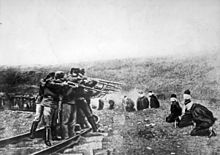
Serbian and French troops finally made a breakthrough in September 1918 in theVardar offensive,after most German and Austro-Hungarian troops had been withdrawn. The Bulgarians were defeated at theBattle of Dobro Pole,and by 25 September British and French troops had crossed the border into Bulgaria proper as the Bulgarian army collapsed. Bulgaria capitulated four days later, on 29 September 1918.[114]The German high command responded by despatching troops to hold the line, but these forces were too weak to re-establish a front.[115]
The disappearance of the Macedonian front meant that the road toBudapestand Vienna was now opened to Allied forces. Hindenburg and Ludendorff concluded that the strategic and operational balance had now shifted decidedly against theCentral Powersand, a day after the Bulgarian collapse, insisted on an immediate peace settlement.[116]
Ottoman Empire

The Ottomans threatened Russia'sCaucasianterritories and Britain's communications with India via theSuez Canal.As the conflict progressed, the Ottoman Empire took advantage of the European powers' preoccupation with the war and conducted large-scale ethnic cleansing of the indigenousArmenian,Greek,andAssyrianChristian populations, known as theArmenian genocide,Greek genocide,andSayforespectively.[117][118][119]
The British and French opened overseas fronts with theGallipoli(1915) andMesopotamian campaigns(1914). In Gallipoli, the Ottoman Empire successfully repelled the British, French, andAustralian and New Zealand Army Corps(ANZACs). InMesopotamia,by contrast, after the defeat of the British defenders in thesiege of Kutby the Ottomans (1915–16), British Imperial forces reorganised and capturedBaghdadin March 1917. The British were aided in Mesopotamia by local Arab and Assyrian fighters, while the Ottomans employed localKurdishandTurcomantribes.[120]
Further to the west, theSuez Canalwas defended from Ottoman attacks in 1915 and 1916; in August 1916, a German and Ottoman force was defeated at theBattle of Romaniby theANZAC Mounted Divisionand the52nd (Lowland) Infantry Division.Following this victory, anEgyptian Expeditionary Forceadvanced across theSinai Peninsula,pushing Ottoman forces back in theBattle of Magdhabain December and theBattle of Rafaon the border between the EgyptianSinaiand Ottoman Palestine in January 1917.[121]

Russian armies generally had success in theCaucasus campaign.Enver Pasha,supreme commander of the Ottoman armed forces, was ambitious and dreamed of re-conquering central Asia and areas that had been previously lost to Russia. He was, however, a poor commander.[122]He launched an offensive against the Russians in the Caucasus in December 1914 with 100,000 troops, insisting on a frontal attack against mountainous Russian positions in winter. He lost 86% of his force at theBattle of Sarikamish.[123]

The Ottoman Empire, with German support, invaded Persia (modernIran) in December 1914 to cut off British and Russian access topetroleum reservoirsaroundBakunear theCaspian Sea.[124]Persia, ostensibly neutral, had long been under the spheres of British and Russian influence. The Ottomans and Germans were aided byKurdishandAzeriforces, together with a large number of major Iranian tribes, such as theQashqai,Tangistanis,Lurs,andKhamseh,while the Russians and British had the support of Armenian and Assyrian forces. ThePersian campaignwas to last until 1918 and end in failure for the Ottomans and their allies. However, the Russian withdrawal from the war in 1917 led Armenian and Assyrian forces, who had hitherto inflicted a series of defeats upon the forces of the Ottomans and their allies, to be cut off from supply lines, outnumbered, outgunned and isolated, forcing them to fight and flee towards British lines in northern Mesopotamia.[125]
GeneralYudenich,the Russian commander from 1915 to 1916, drove the Turks out of most of the southernCaucasuswith a string of victories.[123]
TheArab Revolt,instigated by the Arab bureau of the BritishForeign Office,started in June 1916 with theBattle of Mecca,led bySharif HusseinofMecca.The Sharif declared the independence of theKingdom of Hejazand, with British assistance, conquered much of Ottoman-held Arabia, resulting finally in the Ottoman surrender of Damascus.Fakhri Pasha,the Ottoman commander ofMedina,resisted for more than2+1⁄2years during thesiege of Medinabefore surrendering in January 1919.[126]
TheSenussitribe, along the border ofItalian LibyaandBritish Egypt,incited and armed by the Turks, waged a small-scaleguerrilla waragainst Allied troops. The British were forced to dispatch 12,000 troops to oppose them in theSenussi campaign.Their rebellion was finally crushed in mid-1916.[127]
Total Allied casualties on the Ottoman fronts amounted to 650,000 men. Total Ottoman casualties were 725,000, with 325,000 dead and 400,000 wounded.[128]
Italian Front
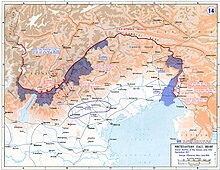
Though Italy joined the Triple Alliance in 1882, a treaty with its traditional Austrian enemy was so controversial that subsequent governments denied its existence and the terms were only made public in 1915.[129]This arose fromnationalistdesigns on Austro-Hungarian territory inTrentino,theAustrian Littoral,RijekaandDalmatia,which were considered vital to secure the borders established in1866.[130]In 1902, Rome secretly had agreed with France to remain neutral if the latter was attacked by Germany, effectively nullifying its role in the Triple Alliance.[131]
When the war began in 1914, Italy argued the Triple Alliance was defensive and it was not obliged to support an Austrian attack on Serbia. Opposition to joining the Central Powers increased when Turkey became a member in September, since in1911Italy had occupied Ottoman possessions inLibyaand theDodecaneseislands.[132]To secure Italian neutrality, the Central Powers offered themTunisia,while in return for an immediate entry into the war, the Allies agreed to their demands for Austrian territory and sovereignty over the Dodecanese.[133]Although they remained secret, these provisions were incorporated into the April 1915Treaty of London;Italy joined the Triple Entente and, on 23 May, declared war on Austria-Hungary,[134]followed by Germany fifteen months later.
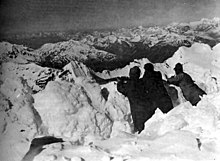
The pre-1914 Italian army was short of officers, trained men, adequate transport and modern weapons; by April 1915, some of these deficiencies had been remedied but it was still unprepared for the major offensive required by the Treaty of London.[135]The advantage of superior numbers was offset by the difficult terrain; much of the fighting took place high in theAlpsandDolomites,where trench lines had to be cut through rock and ice and keeping troops supplied was a major challenge. These issues were exacerbated by unimaginative strategies and tactics.[136]Between 1915 and 1917, the Italian commander,Luigi Cadorna,undertooka series of frontal assaults along the Isonzo,which made little progress and cost many lives; by the end of the war, Italian combat deaths totalled around 548,000.[137]
In the spring of 1916, the Austro-Hungarians counterattacked inAsiagoin theStrafexpedition,but made little progress and were pushed by the Italians back to Tyrol.[138]Although an Italian corps occupied southernAlbaniain May 1916, their main focus was the Isonzo front which, after thecapture of Goriziain August 1916, remained static until October 1917. After a combined Austro-German force won a major victory atCaporetto,Cadorna was replaced byArmando Diazwho retreated more than 100 kilometres (62 mi) before holding positions along thePiave River.[139]A second Austrianoffensive was repulsedin June 1918 and by October it was clear the Central Powers had lost the war. On 24 October, Diaz launched theBattle of Vittorio Venetoand initially met stubborn resistance,[140]but with Austria-Hungary collapsing, Hungarian divisions in Italy demanded they be sent home.[141]When this was granted, many others followed and the Imperial army disintegrated, the Italians taking over 300,000 prisoners.[142]On 3November, theArmistice of Villa Giustiended hostilities between Austria-Hungary and Italy which occupiedTriesteand areas along theAdriatic Seaawarded to it in 1915.[143]
Eastern Front
Initial actions

As previously agreed with France, Russian plans at the start of the war were to simultaneously advance intoAustrian Galiciaand East Prussia as soon as possible. Although theirattack on Galiciawas largely successful, and the invasions achieved their aim of forcing Germany to divert troops from the Western Front, the speed of mobilisation meant they did so without much of their heavy equipment and support functions. These weaknesses contributed to Russian defeats atTannenbergand theMasurian Lakesin August and September 1914, forcing them to withdraw from East Prussia with heavy losses.[144][145]By spring 1915, they had also retreated from Galicia, and the May 1915Gorlice–Tarnów offensiveallowed the Central Powers to invadeRussian-occupied Poland.[146]
Despite the successful June 1916Brusilov offensiveagainst the Austrians in eastern Galicia,[147]shortages of supplies, heavy losses and command failures prevented the Russians from fully exploiting their victory. However, it was one of the most significant offensives of the war, diverting German resources fromVerdun,relieving Austro-Hungarian pressure on the Italians, and convincing Romania to enter the war on the side of the Allies on 27 August. It also fatally weakened both the Austrian and Russian armies, whose offensive capabilities were badly affected by their losses and increased disillusion with the war that ultimately led to the Russian revolutions.[148]
Meanwhile, unrest grew in Russia asthe Tsarremained at the front, with the home front controlled byEmpress Alexandra.Her increasingly incompetent rule and food shortages in urban areas led to widespread protests and the murder of her favourite,Grigori Rasputin,at the end of 1916.[149]
Romanian participation
Despite secretly agreeing to support the Triple Alliance in 1883, Romania increasingly found itself at odds with the Central Powers over their support for Bulgaria in the Balkan Wars and the status of ethnic Romanian communities inHungarian-controlledTransylvania,[150]which comprised an estimated 2.8 million of the 5.0 million population.[151]With the ruling elite split into pro-German and pro-Entente factions, Romania remained neutral in 1914, arguing like Italy that because Austria-Hungary had declared war on Serbia, it was under no obligation to join them.[152]They maintained this position for the next two years while allowing Germany and Austria to transport military supplies and advisors across Romanian territory.[153]
In September 1914, Russia acknowledged Romanian rights to Austro-Hungarian territories including Transylvania andBanat,whose acquisition had widespread popular support,[151]and Russian success against Austria led Romania to join the Entente in the August 1916Treaty of Bucharest.[153]Under the strategic plan known asHypothesis Z,the Romanian army planned an offensive into Transylvania, while defending SouthernDobrujaandGiurgiuagainst a possible Bulgarian counterattack.[154]On 27 August 1916, theyattacked Transylvaniaand occupied substantial parts of the province before being driven back by the recently formedGerman 9th Army,led by former Chief of StaffErich von Falkenhayn.[155]A combined German-Bulgarian-Turkish offensive captured Dobruja and Giurgiu, although the bulk of the Romanian army managed to escape encirclement and retreated toBucharest,whichsurrenderedto the Central Powers on 6 December 1916.[156]
In the summer of 1917, a Central Powers offensive began in Romania under the command of August von Mackensen to knock Romania out of the war, resulting in the battles ofOituz,MărăștiandMărășeștiwhere up to 1,000,000 Central Powers troops were present. The battles lasted from 22 July to 3 September and eventually, the Romanian army was victorious advancing 500 km2.August von Mackensen could not plan for another offensive as he had to transfer troops to the Italian Front.[157]Following the Russian revolution, Romania found itself alone on the Eastern Front and signed theTreaty of Bucharestwith the Central Powers, which recognised Romanian sovereignty overBessarabiain return for ceding control of passes in the Carpathian Mountains to Austria-Hungary and leasing its oil wells to Germany for 99 years. Although approved byParliament,King Ferdinand Irefused to sign it, hoping for an Allied victory in the west.[158]Romania re-entered the war on 10 November 1918 on the side of the Allies and the Treaty of Bucharest was formally annulled by the Armistice of 11 November 1918.[159][m]
Central Powers peace overtures
On 12 December 1916, after ten brutal months of theBattle of Verdunand asuccessful offensive against Romania,Germany attempted to negotiate a peace with the Allies.[161]However, this attempt was rejected out of hand as a "duplicitous war ruse".[161]

US presidentWoodrow Wilsonattempted to intervene as a peacemaker, asking for both sides to state their demands and start negotiations.Lloyd George'sWar Cabinet considered the German offer to be a ploy to create divisions among the Allies. After initial outrage and much deliberation, they took Wilson's note as a separate effort, signalling that the United States was on the verge of entering the war against Germany following the "submarine outrages". While the Allies debated a response to Wilson's offer, the Germans chose to rebuff it in favour of "a direct exchange of views". Learning of the German response, the Allied governments were free to make clear demands in their response of 14 January. They sought restoration of damages, the evacuation of occupied territories, reparations for France, Russia and Romania, and a recognition of the principle of nationalities.[162]This included the liberation of Italians, Slavs, Romanians, Czecho-Slovaks, and the creation of a "free and united Poland".[162]The Allies sought guarantees that would prevent or limit future wars, complete with sanctions, as a condition of any peace settlement.[163]The negotiations failed and the Entente powers rejected the German offer on the grounds of honour, and noted Germany had not put forward any specific proposals.[161]
Final years of the war
Russian Revolution and withdrawal
By the end of 1916, Russian casualties totalled nearly five million killed, wounded or captured, with major urban areas affected by food shortages and high prices. In March 1917, Tsar Nicholas ordered the military to forcibly suppress a wave of strikes inPetrogradbut the troops refused to fire on the crowds.[164]Revolutionaries set up thePetrograd Sovietand fearing a left-wing takeover, theState Dumaforced Nicholas to abdicate and established theRussian Provisional Government,which confirmed Russia's willingness to continue the war. However, the Petrograd Soviet refused to disband, creatingcompeting power centresand causing confusion and chaos, with frontline soldiers becoming increasingly demoralised and unwilling to fight on.[165]
Following the Tsar's abdication,Vladimir Lenin—with the help of the German government—was ushered from Switzerland into Russia on 16 April 1917. Discontent and the weaknesses of the Provisional Government led to a rise in the popularity of the Bolshevik Party, led by Lenin, which demanded an immediate end to the war. The Revolution of November was followed in December by an armistice and negotiations with Germany. At first, the Bolsheviks refused the German terms, but when German troops began marching across Ukraine unopposed, the new government acceded to theTreaty of Brest-Litovskon 3March 1918. The treaty ceded vast territories, including Finland, Estonia, Latvia, Lithuania, and parts of Poland and Ukraine to the Central Powers.[166]
With theRussian Empireout of the war, Romania found itself alone on the Eastern Front and signed theTreaty of Bucharestwith the Central Powers in May 1918, ending the state of war between Romania and theCentral Powers.Under the terms of the treaty, Romania had to give territory to Austria-Hungary and Bulgaria and lease its oil reserves to Germany. However, the terms also included the Central Powers' recognition of the union ofBessarabiawith Romania.[167][168]
United States enters the war
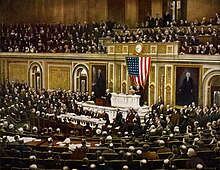
The United States was a major supplier of war material to the Allies but remained neutral in 1914, in large part due to domestic opposition.[169]The most significant factor in creating the support Wilson needed was the German submarine offensive, which not only cost American lives but paralysed trade as ships were reluctant to put to sea.[170]
On 6 April 1917, Congressdeclared war on Germanyas an "Associated Power" of the Allies.[171]TheUnited States Navysent abattleship grouptoScapa Flowto join the Grand Fleet, and provided convoy escorts. In April 1917, theUnited States Armyhad fewer than 300,000 men, includingNational Guardunits, compared to British and French armies of 4.1 and 8.3 million respectively. TheSelective Service Act of 1917drafted 2.8 million men, though training and equipping such numbers was a huge logistical challenge. By June 1918, over 667,000 members of theAmerican Expeditionary Forces(AEF) were transported to France, a figure which reached 2 million by the end of November.[172]
Despite his conviction that Germany must be defeated, Wilson went to war to ensure the US played a leading role in shaping the peace, which meant preserving the AEF as a separate military force, rather than being absorbed into British or French units as his Allies wanted.[173]He was strongly supported by AEF commander GeneralJohn J. Pershing,a proponent of pre-1914 "open warfare" who considered the French and British emphasis on artillery as misguided and incompatible with American "offensive spirit".[174]Much to the frustration of his Allies, who had suffered heavy losses in 1917, he insisted on retaining control of American troops, and refused to commit them to the front line until able to operate as independent units. As a result, the first significant US involvement was theMeuse–Argonne offensivein late September 1918.[175]
Nivelle Offensive (April–May 1917)
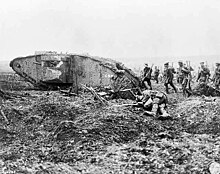
In December 1916,Robert Nivellereplaced Pétain as commander of French armies on the Western Front and began planning aspring attackinChampagne,part of a joint Franco-British operation. Nivelle claimed the capture of his main objective, theChemin des Dames,would achieve a massive breakthrough and cost no more than 15,000 casualties.[176]Poor security meant German intelligence was well informed on tactics and timetables, but despite this, when the attack began on 16 April the French made substantial gains, before being brought to a halt by the newly built and extremely strong defences of the Hindenburg Line. Nivelle persisted with frontal assaults and, by 25 April, the French had suffered nearly 135,000 casualties, including 30,000 dead, most incurred in the first two days.[177]
Concurrent British attacks atArraswere more successful, though ultimately of little strategic value.[178]Operating as a separate unit for the first time, theCanadian Corpscapture ofVimy Ridgeis viewed by many Canadians as a defining moment in creating a sense of national identity.[179][180]Though Nivelle continued the offensive, on 3 May the21st Division,which had been involved in some of the heaviest fighting at Verdun, refused orders to go into battle, initiating theFrench Army mutinies;within days, "collective indiscipline" had spread to 54 divisions, while over 20,000 deserted.[181]Unrest was almost entirely confined to the infantry, whose demands were largely non-political, including better economic support for families at home, and regular periods of leave, which Nivelle had ended.[182]
Sinai and Palestine campaign (1917–1918)
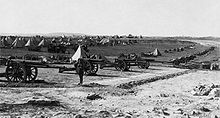
In March and April 1917, at theFirstandSecond Battles of Gaza,German and Ottoman forces stopped the advance of the Egyptian Expeditionary Force, which had begun in August 1916 at the Battle of Romani.[183][184]At the end of October 1917, theSinai and Palestine campaignresumed, when GeneralEdmund Allenby'sXXth Corps,XXI CorpsandDesert Mounted Corpswon theBattle of Beersheba.[185]Two Ottoman armies were defeated a few weeks later at theBattle of Mughar Ridgeand, early in December,Jerusalemhad been captured following another Ottoman defeat at theBattle of Jerusalem.[186][187][188]About this time,Friedrich Freiherr Kress von Kressensteinwas relieved of his duties as the Eighth Army's commander, replaced byDjevad Pasha,and a few months later the commander of theOttoman Armyin Palestine,Erich von Falkenhayn,was replaced byOtto Liman von Sanders.[189][190]
In early 1918, the front line wasextendedand theJordan Valleywas occupied, following theFirst Transjordanand theSecond Transjordanattacks by British Empire forces in March and April 1918.[191]
German offensive and Allied counter-offensive (March–November 1918)

In December 1917, the Central Powers signed an armistice with Russia, thus freeing large numbers of German troops for use in the West. With German reinforcements and new American troops pouring in, the outcome was to be decided on the Western Front. The Central Powers knew that they could not win a protracted war, but they held high hopes for success in a final quick offensive.[193]Ludendorff drew up plans (codenamedOperation Michael) for the 1918 offensive on the Western Front. The operation commenced on 21 March 1918, with an attack on British forces nearSaint-Quentin.German forces achieved an unprecedented advance of 60 kilometres (37 mi).[194]The initial offensive was a success; after heavy fighting, however, the offensive was halted. Lacking tanks ormotorised artillery,the Germans were unable to consolidate their gains. The problems of re-supply were also exacerbated by increasing distances that now stretched over terrain that was shell-torn and often impassable to traffic.[195]
Following this, Germany launchedOperation Georgetteagainst the northernEnglish Channelports. The Allies halted the drive after limited territorial gains by Germany. The German Army to the south then conductedOperations Blücher and Yorck,pushing broadly towards Paris. Germany launched Operation Marne (Second Battle of the Marne) on 15 July, in an attempt to encircleReims.The resulting counter-attack, which started theHundred Days Offensiveon 8 August,[196]led to a marked collapse in German morale.[197][198][199]
Allied advance to the Hindenburg Line

By September, the Germans had fallen back to the Hindenburg Line. The Allies hadadvanced to the Hindenburg Linein the north and centre. German forces launched numerous counterattacks, but positions and outposts of the Line continued falling, with the BEF alone taking 30,441 prisoners in the last week of September. On 24 September, the Supreme Army Command informed the leaders in Berlin that armistice talks were inevitable.[200]
Thefinal assaulton the Hindenburg Line began with theMeuse-Argonne offensive,launched by American and French troops on 26 September. Two days later the Allied armies (Belgian, French and British)attacked around Ypres,and the day after the British Fourth and French First Army at St Quentin in the centre of the line. The following week, cooperating American and French units broke through inChampagneat theBattle of Blanc Mont Ridge(3–27 October), forcing the Germans off the commanding heights, and closing towards the Belgian frontier.[201]On 8October, the Hindenburg Line was pierced by British and Dominion troops of the First and Third British Armies at theSecond Battle of Cambrai.[202]
Breakthrough of Macedonian Front (September 1918)

Allied forces started theVardar offensiveon 15 September at two key points:Dobro Poleand nearDojran Lake.In theBattle of Dobro Pole,the Serbian and French armies had success after a three-day-long battle with relatively small casualties, and subsequently made a breakthrough in the front, something which was rarely seen in World War I. After the front was broken, Allied forces started to liberate Serbia and reachedSkopjeat 29 September, after whichBulgariasigned an armistice with the Allies on 30 September.[203][204]
Armistices and capitulations
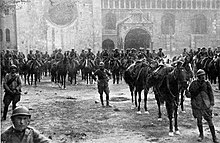
The collapse of the Central Powers came swiftly. Bulgaria was the first to sign an armistice, theArmistice of Salonicaon 29 September 1918.[205]German EmperorWilhelm IIin a telegram toBulgarian Tsar Ferdinand Idescribed the situation thus: "Disgraceful! 62,000 Serbs decided the war!".[206][207]On the same day, theGerman Supreme Army Commandinformed Kaiser Wilhelm II and theImperial ChancellorCountGeorg von Hertling,that the military situation facing Germany was hopeless.[208]
On 24 October, the Italians began a push that rapidly recovered territory lost after the Battle of Caporetto. This culminated in the Battle of Vittorio Veneto, marking the end of the Austro-Hungarian Army as an effective fighting force. The offensive also triggered the disintegration of the Austro-Hungarian Empire. During the last week of October, declarations of independence were made in Budapest, Prague, and Zagreb. On 29 October, the imperial authorities asked Italy for an armistice, but the Italians continued advancing, reaching Trento, Udine, and Trieste. On 3November, Austria-Hungary sent aflag of truceto ask for anarmistice(Armistice of Villa Giusti). The terms, arranged with the Allied Authorities in Paris, were communicated to the Austrian commander and accepted. The Armistice with Austria was signed in the Villa Giusti, nearPadua,on 3November. Austria and Hungary signed separate armistices following the overthrow of theHabsburg monarchy.In the following days, the Italian Army occupiedInnsbruckand allTyrol,with over 20,000 soldiers.[209]
On 30 October, the Ottoman Empire capitulated, and signed the Armistice of Mudros.[205]
German government surrenders

With the military faltering and with widespread loss of confidence in the Kaiser leading to his abdication and fleeing of the country, Germany moved towards surrender. Prince Maximilian of Baden took charge of a new government on October 3 as Chancellor of Germany to negotiate with the Allies. Negotiations with President Wilson began immediately, in the hope that he would offer better terms than the British and French. Wilson demanded a constitutional monarchy and parliamentary control over the German military.[211]
In northern Germany, theGerman Revolution of 1918–1919began at the end of October 1918. Units of the German Navy refused to set sail for a last, large-scale operation in a war they believed to be as good as lost, initiating the uprising. Thesailors' revolt,which then ensued in the naval ports ofWilhelmshavenandKiel,spread across the whole country within days and led to theproclamation of a republicon 9November 1918, shortly thereafter to theabdication of Kaiser Wilhelm II,and German surrender.[212][213][214][215][216]
Aftermath
In the aftermath of the war, four empires disappeared: the German, Austro-Hungarian, Ottoman, and Russian.[n]Numerous nations regained their former independence, and new ones were created. Four dynasties fell as a result of the war: theRomanovs,theHohenzollerns,theHabsburgs,and theOttomans.Belgium and Serbia were badly damaged, as was France, with 1.4 million soldiers dead,[217]not counting other casualties. Germany and Russia were similarly affected.[218]
Formal end of the war

A formal state of war between the two sides persisted for another seven months, until the signing of theTreaty of Versailleswith Germany on 28 June 1919. The United States Senate did not ratify the treaty despite public support for it,[219][220]and did not formally end its involvement in the war until theKnox–Porter Resolutionwas signed on 2July 1921 by PresidentWarren G. Harding.[221]For the British Empire, the state of war ceased under the provisions of theTermination of the Present War (Definition) Act 1918concerning:

Somewar memorialsdate the end of the war as being when the Versailles Treaty was signed in 1919, which was when many of the troops serving abroad finally returned home; by contrast, most commemorations of the war's end concentrate on the armistice of 11 November 1918.[227]
Peace treaties and national boundaries

After the war, there grew a certain amount of academic focus on the causes of war and on the elements that could make peace flourish. In part, these led to the institutionalization of peace and conflict studies, security studies and International Relations (IR) in general.[228]TheParis Peace Conferenceimposed a series of peace treaties on the Central Powers officially ending the war. The 1919Treaty of Versaillesdealt with Germany and, building onWilson's 14th point,established theLeague of Nationson 28 June 1919.[229][230]
The Central Powers had to acknowledge responsibility for "all the loss and damage to which the Allied and Associated Governments and their nationals have been subjected as a consequence of the war imposed upon them by" their aggression. In the Treaty of Versailles, this statement wasArticle 231.This article became known as the "War Guilt Clause", as the majority of Germans felt humiliated and resentful.[231]Overall, the Germans felt they had been unjustly dealt with by what they called the "diktatof Versailles ". German historian Hagen Schulze said the Treaty placed Germany" under legal sanctions, deprived of military power, economically ruined, and politically humiliated. "[232]Belgian historian Laurence Van Ypersele emphasises the central role played by memory of the war and the Versailles Treaty in German politics in the 1920s and 1930s:
Active denial of war guilt in Germany and German resentment at both reparations and continued Allied occupation of the Rhineland made widespread revision of the meaning and memory of the war problematic. The legend of the "stab in the back"and the wish to revise the" Versailles diktat ", and the belief in an international threat aimed at the elimination of the German nation persisted at the heart of German politics. Even a man of peace such as [Gustav] Stresemann publicly rejected German guilt. As for the Nazis, they waved the banners of domestic treason and international conspiracy in an attempt to galvanise the German nation into a spirit of revenge. Like a Fascist Italy, Nazi Germany sought to redirect the memory of the war to the benefit of its policies.[233]
Meanwhile, new nations liberated from German rule viewed the treaty as a recognition of wrongs committed against small nations by much larger aggressive neighbours.[234]

Austria-Hungary was partitioned into several successor states, largely but not entirely along ethnic lines. Apart from Austria and Hungary, Czechoslovakia, Italy, Poland, Romania and Yugoslavia received territories from the Dual Monarchy (the formerly separate and autonomousKingdom of Croatia-Slavoniawas incorporated into Yugoslavia). The details were contained in the treaties ofSaint-Germain-en-LayeandTrianon.As a result, Hungary lost 64% of its total population, decreasing from 20.9 million to 7.6 million, and losing 31% (3.3 out of 10.7 million) of its ethnicHungarians.[235]According to the 1910 census, speakers of the Hungarian language included approximately 54% of the entire population of theKingdom of Hungary.Within the country, numerous ethnic minorities were present: 16.1%Romanians,10.5%Slovaks,10.4%Germans,2.5%Ruthenians,2.5%Serbsand 8% others.[236]Between 1920 and 1924, 354,000 Hungarians fled former Hungarian territories attached to Romania, Czechoslovakia, and Yugoslavia.[237]
The Russian Empire, which withdrew from the war in 1917 after the October Revolution, lost much of its western frontier as the newly independent nations ofEstonia,Finland,Latvia,Lithuania,andPolandwere carved from it. Romania took control of Bessarabia in April 1918.[238]
National identities
After 123 years, Poland re-emerged as an independent country. The Kingdom of Serbia and its dynasty, as a "minor Entente nation" and the country with the most casualties per capita,[239][240][241]became the backbone of a new multinational state, theKingdom of Serbs, Croats and Slovenes,later renamed Yugoslavia. Czechoslovakia, combining theKingdom of Bohemiawith parts of the Kingdom of Hungary, became a new nation. Romania woulduniteall Romanian-speaking people under a single state, leading toGreater Romania.[242]
In Australia and New Zealand, the Battle of Gallipoli became known as those nations' "Baptism of Fire". It was the first major war in which the newly established countries fought, and it was one of the first times that Australian troops fought as Australians, not just subjects of theBritish Crown,and independent national identities for these nations took hold.Anzac Day,commemorating the Australian and New Zealand Army Corps (ANZAC), celebrates this defining moment.[243][244]
In the aftermath of World War I, Greecefoughtagainst Turkish nationalists led byMustafa Kemal,a war that eventually resulted in amassive population exchange between the two countriesunder the Treaty of Lausanne.[245]According to various sources,[246]several hundred thousand Greeks died during this period, which was tied in with the Greek genocide.[247]
Casualties

Of the 60 million European military personnel who were mobilised from 1914 to 1918, an estimated8 million were killed,7 million were permanently disabled, and 15 million were seriously injured. Germany lost 15.1% of its active male population, Austria-Hungary lost 17.1%, and France lost 10.5%.[248]France mobilised 7.8 million men, of which 1.4 million died and 3.2 million were injured.[249]Approximately 15,000 sustained horrific facial injuries, causing social stigma and marginalisation; they were called thegueules cassées.In Germany, civilian deaths were 474,000 higher than in peacetime, due in large part to food shortages and malnutrition that had weakened disease resistance. These excess deaths are estimated as 271,000 in 1918, plus another 71,000 in the first half of 1919 when the blockade was still in effect.[250]Starvation caused by famine killed approximately 100,000 people in Lebanon.[251]
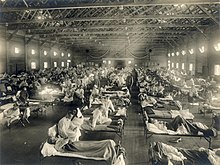
Diseases flourished in the chaotic wartime conditions. In 1914 alone, louse-borneepidemic typhuskilled 200,000 in Serbia.[252]Starting in early 1918, a major influenza epidemic known asSpanish fluspread around the world, accelerated by the movement of large numbers of soldiers, often crammed together in camps and transport ships with poor sanitation. The Spanish flu killed at least 17 million to 25 million people,[253][254]including an estimated 2.64 million Europeans and as many as 675,000 Americans.[255]Between 1915 and 1926, an epidemic ofencephalitis lethargicaspread around the world affecting nearly five million people.[256][257]
8 millionequinesincludinghorses,donkeysandmulesdied, three-quarters of them from the extreme conditions they worked in.[258]
War crimes
Chemical weapons in warfare

The German army was the first to successfully deploy chemical weapons during the Second Battle of Ypres (22 April – 25 May 1915), after German scientists working under the direction ofFritz Haberat theKaiser Wilhelm Institutedeveloped a method to weaponizechlorine.[o][260]The use of chemical weapons had been sanctioned by the German High Command to force Allied soldiers out of their entrenched positions, complementing rather than supplanting more lethal conventional weapons.[260]In time, chemical weapons were deployed by all major belligerents throughout the war, inflicting approximately 1.3 million casualties, of which about 90,000 were fatal.[260]For example, there were an estimated 186,000 British chemical weapons casualties during the war (80% of which were the result of exposure to thevesicant'mustard gas', introduced to the battlefield by the Germans in July 1917),[260]and up to one-third of American casualties were caused by them. The Russian Army reportedly suffered roughly 500,000 chemical weapon casualties in World WarI.[261]The use of chemical weapons in warfare was a direct violation of the1899 Hague Declaration Concerning Asphyxiating Gasesand the1907 Hague Convention on Land Warfare,which prohibited their use.[262][263]
Genocides by the Ottoman Empire

Theethnic cleansingof the Ottoman Empire's Armenian population, including mass deportations and executions, during the final years of the Ottoman Empire is consideredgenocide.[265]The Ottomans carried out organised and systematic massacres of the Armenian population at the beginning of the war and manipulated acts of Armenian resistance by portraying them as rebellions to justify further extermination.[266]In early 1915, several Armenians volunteered to join the Russian forces and the Ottoman government used this as a pretext to issue theTehcir Law(Law on Deportation), which authorised the deportation of Armenians from the Empire's eastern provinces to Syria between 1915 and 1918. The Armenians were intentionallymarched to deathand a number were attacked by Ottoman brigands.[267]While an exact number of deaths is unknown, theInternational Association of Genocide Scholarsestimates 1.5 million.[265][268]The government of Turkey continues todeny the genocideto the present day, arguing that those who died were victims of inter-ethnic fighting, famine, or disease during World WarI; these claims are rejected by most historians.[269]
Other ethnic groups were similarly attacked by the Ottoman Empire during this period, including Assyrians andGreeks,and some scholars consider those events to be part of the same policy of extermination.[270][271][272]At least 250,000 Assyrian Christians, about half of the population, and 350,000–750,000AnatolianandPontic Greekswere killed between 1915 and 1922.[273]
Prisoners of war

About eight million soldiers surrendered and were held inPOW campsduring the war. All nations pledged to follow theHague Conventionson fair treatment ofprisoners of war,and the survival rate for POWs was generally much higher than that of combatants at the front.[274]
25–31% of Russian losses (as a proportion of those captured, wounded, or killed) were to prisoner status; for Austria-Hungary 32%; for Italy 26%; for France 12%; for Germany 9%; for Britain 7%. Prisoners from the Allied armies totalled about 1.4 million (not including Russia, which lost 2.5–3.5 million soldiers as prisoners). From the Central Powers, about 3.3 million soldiers became prisoners; most of them surrendered to Russians.[275]
Soldiers' experiences
Allied personnel was around 42,928,000, while Central personnel was near 25,248,000.[218][276]The British soldiers of the war were initially volunteers but increasingly wereconscripted.Surviving veterans, returning home, often found they could discuss their experiences only among themselves. Grouping, they formed "veterans' associations" or "Legions". A small number of personal accounts of American veterans have been collected by the Library of CongressVeterans History Project.[277]
Conscription

Conscription was common in most European countries. However, it was controversial in English-speaking countries.[278]It was especially unpopular among minority ethnicities—especially the Irish Catholics in Ireland,[279]Australia,[280][281]and the French Catholics in Canada.[282][283]
In the United States, conscription began in 1917 and was generally well-received, with a few pockets of opposition in isolated rural areas.[284]The administration decided to rely primarily on conscription, rather than voluntary enlistment, to raise military manpower after only 73,000 volunteers enlisted out of the initial 1million target in the first six weeks of the war.[285]
Military attachés and war correspondents
Military and civilian observers from every major power closely followed the course of the war. Many were able to report on events from a perspective somewhat akin to modern "embedded"positions within the opposing land and naval forces.
Economic effects
Macro- and micro-economic consequences devolved from the war. Families were altered by the departure of many men. With the death or absence of the primary wage earner, women were forced into the workforce in unprecedented numbers. At the same time, the industry needed to replace the lost labourers sent to war. This aided the struggle forvoting rights for women.[286]

In all nations, the government's share of GDP increased, surpassing 50% in both Germany and France and nearly reaching that level in Britain. To pay for purchases in the United States, Britain cashed in its extensive investments in American railroads and then began borrowing heavily fromWall Street.President Wilson was on the verge of cutting off the loans in late 1916 but allowed a great increase inUS governmentlending to the Allies. After 1919, the US demanded repayment of these loans. The repayments were, in part, funded by German reparations that, in turn, were supported by American loans to Germany. This circular system collapsed in 1931 and some loans were never repaid. Britain still owed the United States $4.4billion[p]of World WarI debt in 1934; the last installment was finally paid in 2015.[287]
Britain turned to her colonies for help in obtaining essential war materials whose supply from traditional sources had become difficult. Geologists such asAlbert Kitsonwere called on to find new resources of precious minerals in the African colonies. Kitson discovered important new deposits ofmanganese,used in munitions production, in theGold Coast.[288]
Article 231 of the Treaty of Versailles (the so-called "war guilt" clause) stated Germany accepted responsibility for "all the loss and damage to which the Allied and Associated Governments and their nationals have been subjected as a consequence of the war imposed upon them by the aggression of Germany and her allies."[289]It was worded as such to lay a legal basis for reparations, and a similar clause was inserted in the treaties with Austria and Hungary. However, neither of them interpreted it as an admission of war guilt.[290]In 1921, the total reparation sum was placed at 132 billion gold marks. However, "Allied experts knew that Germany could not pay" this sum. The total sum was divided into three categories, with the third being "deliberately designed to be chimerical" and its "primary function was to mislead public opinion... into believing the 'total sum was being maintained.'"[291]Thus, 50 billion gold marks (12.5 billion dollars) "represented the actual Allied assessment of German capacity to pay" and "therefore… represented the total German reparations" figure that had to be paid.[291]
This figure could be paid in cash or in-kind (coal, timber, chemical dyes, etc.). In addition, some of the territory lost—via the Treaty of Versailles—was credited towards the reparation figure as were other acts such as helping to restore the Library of Louvain.[292]By 1929, theGreat Depressionarrived, causing political chaos throughout the world.[293]In 1932 the payment of reparations was suspended by the international community, by which point Germany had paid only the equivalent of 20.598 billion gold marks in reparations.[294]With the rise of Adolf Hitler, all bonds and loans that had been issued and taken out during the 1920s and early 1930s were cancelled.David Andelmannotes "Refusing to pay doesn't make an agreement null and void. The bonds, the agreement, still exist." Thus, following the Second World War, at theLondon Conferencein 1953, Germany agreed to resume payment on the money borrowed. On 3October 2010, Germany made the final payment on these bonds.[q]
The Australian prime minister,Billy Hughes,wrote to the British prime minister,David Lloyd George,"You have assured us that you cannot get better terms. I much regret it, and hope even now that some way may be found of securing agreement for demanding reparation commensurate with the tremendous sacrifices made by the British Empire and her Allies." Australia received £5,571,720 in war reparations, but the direct cost of the war to Australia had been £376,993,052, and, by the mid-1930s, repatriation pensions, war gratuities, interest and sinking fund charges were £831,280,947.[299]Of about 416,000 Australians who served, about 60,000 were killed and another 152,000 were wounded.[218]
The war contributed to the evolution of thewristwatchfrom women's jewellery to a practical everyday item, replacing thepocketwatch,which requires a free hand to operate.[300]Trench watcheswere designed for use by the military as pocket watches were not as effective for combat. Military funding of advancements in radio contributed to the postwar popularity of the medium.[300]
Support and opposition for the war
Support

In the Balkans,Yugoslav nationalistssuch as the leader,Ante Trumbić,strongly supported the war, desiring the freedom ofYugoslavsfrom Austria-Hungary and other foreign powers and the creation of an independent Yugoslavia. TheYugoslav Committee,led by Trumbić, was formed in Paris on 30 April 1915 but shortly moved its office to London.[301]In April 1918, the Rome Congress of Oppressed Nationalities met, includingCzechoslovak,Italian,Polish,Transylvanian,and Yugoslav representatives who urged the Allies to support nationalself-determinationfor the peoples residing within Austria-Hungary.[302]
In the Middle East,Arab nationalismsoared in Ottoman territories in response to the rise of Turkish nationalism during the war, with Arab nationalist leaders advocating the creation of apan-Arabstate. In 1916, the Arab Revolt began in Ottoman-controlled territories of the Middle East to achieve independence.[303]
In East Africa,Iyasu VofEthiopiawas supporting theDervish statewho were at war with the British in theSomaliland campaign.[304]Von Syburg, the German envoy inAddis Ababa,said, "now the time has come for Ethiopia to regain the coast of the Red Sea driving the Italians home, to restore the Empire to its ancient size." The Ethiopian Empire was on the verge of entering World WarI on the side of the Central Powers before Iyasu's overthrow at theBattle of Segaledue to Allied pressure on the Ethiopian aristocracy.[305]Iyasu was accused of converting toIslam.[306]According to Ethiopian historianBahru Zewde,the evidence used to prove Iyasu's conversion was a doctored photo of Iyasu wearing a turban provided by the Allies.[307]Some historians claim the British spyT. E. Lawrenceforged the photo.[308]

Several socialist parties initially supported the war when it began in August 1914.[302]But European socialists split on national lines, with the concept ofclass conflictheld by radical socialists such as Marxists andsyndicalistsbeing overborne by their patriotic support for the war.[309]Once the war began, Austrian, British, French, German, and Russian socialists followed the rising nationalist current by supporting their countries' intervention in the war.[310]
Italian nationalismwas stirred by the outbreak of the war and was initially strongly supported by a variety of political factions. One of the most prominent and popular Italian nationalist supporters of the war wasGabriele D'Annunzio,who promotedItalian irredentismand helped sway the Italian public to support intervention in the war.[311]TheItalian Liberal Party,under the leadership ofPaolo Boselli,promoted intervention in the war on the side of the Allies and used the Dante Alighieri Society to promote Italian nationalism.[312]Italian socialists were divided on whether to support the war or oppose it; some were militant supporters of the war, includingBenito MussoliniandLeonida Bissolati.[313]However, theItalian Socialist Partydecided to oppose the war after anti-militarist protestors were killed, resulting in ageneral strikecalledRed Week.[314]The Italian Socialist Party purged itself of pro-war nationalist members, including Mussolini.[314]Mussolini, a syndicalist who supported the war on grounds of irredentist claims on Italian-populated regions of Austria-Hungary, formed the pro-interventionistIl Popolo d'Italiaand theFasci Rivoluzionario d'Azione Internazionalista( "RevolutionaryFascifor International Action ") in October 1914 that later developed into theFasci Italiani di Combattimentoin 1919, the origin of fascism.[315]Mussolini's nationalism enabled him to raise funds fromAnsaldo(an armaments firm) and other companies to createIl Popolo d'Italiato convince socialists and revolutionaries to support the war.[316]
Patriotic funds
On both sides, there was large-scale fundraising for soldiers' welfare, their dependents and those injured. TheNail Menwere a German example. Around the British Empire, there were many patriotic funds, including theRoyal Patriotic Fund Corporation,Canadian Patriotic Fund,Queensland Patriotic Fundand, by 1919, there were 983 funds in New Zealand.[317]At the start of the next world war the New Zealand funds were reformed, having been criticised as overlapping, wasteful and abused,[318]but 11 were still functioning in 2002.[319]
Opposition
Many countries jailed those who spoke out against the conflict. These includedEugene Debsin the United States andBertrand Russellin Britain. In the US, theEspionage Act of 1917andSedition Act of 1918made it a federal crime to oppose military recruitment or make any statements deemed "disloyal". Publications at all critical of the government were removed from circulation by postal censors,[320]and many served long prison sentences for statements of fact deemed unpatriotic.
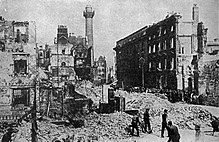
Several nationalists opposed intervention, particularly within states that the nationalists were hostile to. Although the vast majority of Irish people consented to participate in the war in 1914 and 1915, a minority of advancedIrish nationalistshad staunchly opposed taking part.[321]The war began amid the Home Rule crisis in Ireland that had resurfaced in 1912, and by July 1914 there was a serious possibility of an outbreak of civil war in Ireland. Irish nationalists and Marxists attempted to pursue Irish independence, culminating in theEaster Risingof 1916, with Germany sending 20,000 rifles to Ireland to stir unrest in Britain.[322]The British government placed Ireland undermartial lawin response to the Easter Rising, though once the immediate threat of revolution had dissipated, the authorities did try to make concessions to nationalist feeling.[323]However, opposition to involvement in the war increased in Ireland, resulting in theConscription Crisis of 1918.
Other opposition came fromconscientious objectors—some socialist, some religious—who had refused to fight. In Britain, 16,000 people asked for conscientious objector status.[324]Some of them, most notably prominent peace activistStephen Hobhouse,refused both military andalternative service.[325]Many suffered years of prison, includingsolitary confinementand bread and water diets. Even after the war, in Britain, many job advertisements were marked "No conscientious objectors need to apply".[326]
On 1–4 May 1917, about 100,000 workers and soldiers ofPetrograd,and after them, the workers and soldiers of other Russian cities, led by the Bolsheviks, demonstrated under banners reading "Down with the war!" and "all power to the Soviets!". The mass demonstrations resulted in a crisis for theRussian Provisional Government.[327]InMilan,in May 1917, Bolshevik revolutionaries organised and engaged in rioting calling for an end to the war, and managed to close down factories and stop public transportation.[328]The Italian army was forced to enter Milan with tanks and machine guns to face Bolsheviks andanarchists,who fought violently until May 23 when the army gained control of the city. Almost 50 people (including three Italian soldiers) were killed and over 800 people were arrested.[328]
Technology

World War I began as a clash of 20th-century technology and 19th-centurytactics,with the inevitably large ensuing casualties. By the end of 1917, however, the major armies, now numbering millions of men, had modernised and were making use of telephone,wireless communication,[330]armoured cars,tanks(especially with the advent of the prototype tank,Little Willie), and aircraft.[331]

Artillery also underwent a revolution. In 1914, cannons were positioned in the front line and fired directly at their targets. By 1917,indirect firewith guns (as well as mortars and even machine guns) was commonplace, using new techniques for spotting and ranging, notably, aircraft and the often overlookedfield telephone.[332]
Fixed-wing aircraftwere initially used forreconnaissanceandground attack.To shoot down enemy planes,anti-aircraft gunsandfighter aircraftwere developed.Strategic bomberswere created, principally by the Germans and British, though the former usedZeppelinsas well.[333]Towards the end of the conflict, aircraft carriers were used for the first time, with HMSFuriouslaunchingSopwith Camelsin a raid to destroy the Zeppelin hangars atTønderin 1918.[334]
Diplomacy
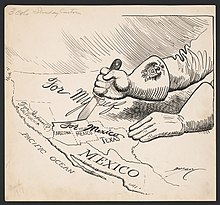
The non-military diplomatic and propaganda interactions among the nations were designed to build support for the cause or to undermine support for the enemy. For the most part, wartime diplomacy focused on five issues:propaganda campaigns;defining and redefining the war goals, which became harsher as the war went on; luring neutral nations (Italy, Ottoman Empire, Bulgaria, Romania) into the coalition by offering slices of enemy territory; and encouragement by the Allies of nationalistic minority movements inside the Central Powers, especially among Czechs, Poles, and Arabs. In addition, multiple peace proposals were coming from neutrals, or one side or the other; none of them progressed very far.[335][336][337]
Legacy and memory
Memorials
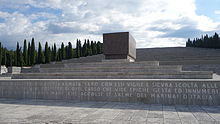
Memorials were built in thousands of villages and towns. Close to battlefields, those buried in improvised burial grounds were gradually moved to formal graveyards under the care of organisations such as theCommonwealth War Graves Commission,theAmerican Battle Monuments Commission,theGerman War Graves Commission,andLe Souvenir français.Many of these graveyards also have monuments to the missing orunidentifieddead, such as theMenin Gate Memorial to the Missingand theThiepval Memorial to the Missing of the Somme.[338][339]
In 1915,John McCrae,a Canadian army doctor, wrote the poemIn Flanders Fieldsas a salute to those who perished in the war. Published inPunchon 8December 1915, it is still recited today, especially onRemembrance DayandMemorial Day.[340][341]
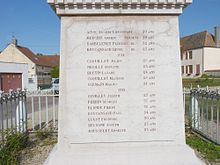
National World War I Museum and MemorialinKansas City, Missouri,is a memorial dedicated to all Americans who served in World WarI. TheLiberty Memorialwas dedicated on 1November 1921, when the supreme Allied commanders spoke to a crowd of more than 100,000 people.[342]
The British government has budgeted substantial resources tothe commemoration of the war during the period 2014 to 2018.The lead body is theImperial War Museum.[343]On 3August 2014, French PresidentFrançois Hollandeand German PresidentJoachim Gaucktogether markedthe centenary of Germany's declaration of war on Franceby laying the first stone of a memorial in Vieil Armand, known in German asHartmannswillerkopf,for French and German soldiers killed in the war.[344]During theArmistice centenary commemorations,French PresidentEmmanuel Macronand German ChancellorAngela Merkelvisited the site of the signing of the Armistice of Compiègne and unveiled a plaque to reconciliation.[345]
Historiography
... "Strange, friend," I said, "Here is no cause to mourn."
"None," said the other, "Save the undone years"...— Wilfred Owen,Strange Meeting,1918[346]
The first tentative efforts to comprehend the meaning and consequences ofmodern warfarebegan during the initial phases of the war; this process continued throughout and after the end of hostilities and is still underway more than a century later. Teaching World War I has presented special challenges. When compared withWorld War II,the First World War is often thought to be "a wrong war fought for the wrong reasons"; it lacks themetanarrativeofgood versus evilthat characterizes retellings of the Second World War. Lacking recognizable heroes and villains, it is often taught thematically, invokingtropeslike the wastefulness of war, the folly of generals and the innocence of soldiers. The complexity of the conflict is mostly obscured by these oversimplifications.[347]George Kennanreferred to the war as the "seminal catastrophe of the 20th century".[348]
Historian Heather Jones argues that thehistoriographyhas been reinvigorated by a cultural turn in the 21st century. Scholars have raised entirely new questions regardingmilitary occupation,radicalisationof politics,race,medical science,genderandmental health.Among the major subjects that historians have long debated regarding the war include:Why the war began;why theAllieswon; whether generals were responsible forhigh casualty rates;how soldiers endured the poor conditions oftrench warfare;and to what extent the civilianhome frontaccepted and endorsed the war effort.[349][350]
Unexploded ordnance
As late as 2007, signs warning visitors to keep off certain paths at battlefield sites likeVerdunandSommeremained in place asunexploded ordnancecontinued to pose a danger. In France and Belgium locals who discover caches of unexploded munitions are assisted by weapons disposal units. In some places, plant life has still not returned to normal.[347]
See also
- Lists of World War I topics
- List of military engagements of World War I
- Outline of World War I
- World war
- World War II
Footnotes
- ^Russian Empire during 1914–1917,Russian Republicduring 1917. TheBolshevikgovernment signed aseparate peacewith the Central Powers shortly after theirarmed seizure of power,resulting in a Central Powers victory on theEastern Frontof the war, and Russian defeat. However, this peace treaty was nullified by an Allied Powers victory on theWestern Front,and the end of the war.
- ^The United States did not ratify any of the treaties agreed to at theParis Peace Conference.
- ^Bulgaria joined the Central Powers on 14 October 1915.
- ^The Ottoman Empire agreed to a secret alliance with Germany on 2 August 1914. It joined the war on the side of the Central Powers on 29 October 1914.
- ^The United Statesdeclared war on Austria-Hungaryon 7December 1917.
- ^Austriawas considered one of thesuccessor statesto Austria-Hungary.
- ^The United Statesdeclared war on Germanyon 6April 1917.
- ^Hungarywas considered one of the successor states to Austria-Hungary.
- ^Although theTreaty of Sèvreswas intended to end the war between the Allied Powers and the Ottoman Empire, the Allied Powers and theRepublic of Turkey,the successor state of the Ottoman Empire, agreed to the Treaty of Lausanne.
- ^Often abbreviated asWWIorWW1;also calledthe Great War.
- ^Only the Triple Alliance was a formal "alliance"; the others listed were informal patterns of support.
- ^German:Skagerrakschlacht,or "Battle of theSkagerrak"
- ^Bessarabia remained part of Romania until 1940, when it was annexed byJoseph Stalinas theMoldavian Soviet Socialist Republic;[160]following the dissolution of the USSR in 1991, it became the independent Republic ofMoldova
- ^Unlike the others, the successor state to the Russian Empire, the Union of Soviet Socialist Republics, retained similar external borders, via retaining or quickly recovering lost territories.
- ^AGerman attemptto use chemical weapons on the Russian front in January 1915 failed to cause casualties.[259]
- ^109in this context – seeLong and short scales
- ^World War I officially ended when Germany paid off the final amount of reparations imposed on it by the Allies.[295][296][297][298]
References
- ^Shapiro & Epstein 2006,p. 329.
- ^Braybon 2004,p. 8.
- ^"The Great War".The Independent.17 August 1914. p. 228.Retrieved17 May2022.
- ^"great, adj., adv., and n".Oxford English Dictionary.Archivedfrom the original on 14 May 2019.Retrieved19 March2012.
- ^"The war to end all wars".BBC News.10 November 1998.Archivedfrom the original on 19 June 2015.Retrieved15 December2015.
- ^Clark 2013,pp. 121–152.
- ^Zeldin 1977,p. 117.
- ^Bertrand Joly, "La France et la Revanche (1871–1914)",Revue d’Histoire Moderne & Contemporaine.1999, vol. 46-2, pp. 325–347[1]Archived27 January 2024 at theWayback Machine
- ^Keegan 1998,p. 52.
- ^Medlicott 1945,pp. 66–70.
- ^Keenan 1986,p. 20.
- ^Willmott 2003,p. 15.
- ^Fay 1930,pp. 290–293.
- ^abWillmott 2003,p. 21.
- ^Herwig 1988,pp. 72–73.
- ^Moll & Luebbert 1980,pp. 153–185.
- ^Stevenson 2016,p. 45.
- ^Crisp 1976,pp. 174–196.
- ^Stevenson 2016,p. 42.
- ^McMeekin 2015,pp. 66–67.
- ^Clark 2013,p. 86.
- ^Clark 2013,pp. 251–252.
- ^McMeekin 2015,p. 69.
- ^McMeekin 2015,p. 73.
- ^Willmott 2003,pp. 2–23.
- ^Clark 2013,p. 288.
- ^Keegan 1998,pp. 48–49.
- ^Finestone & Massie 1981,p. 247.
- ^Smith 2010.
- ^Roger L. Ransom (2018).Gambling on War: Confidence, Fear, and the Tragedy of the First World War.Cambridge University Press. p. 51.ISBN9781108485029.
- ^Butcher 2014,p. 103.
- ^Butcher 2014,pp. 188–189.
- ^Gilbert 1994,p. 16.
- ^Gilbert 1994,p. 17.
- ^Willmott 2003,p. 26.
- ^Clark, Christopher (25 June 2014).Month of Madness.BBC Radio 4.Archivedfrom the original on 20 April 2017.Retrieved14 March2017.
- ^Djordjević, Dimitrije;Spence, Richard B.(1992).Scholar, patriot, mentor: historical essays in honour of Dimitrije Djordjević.East European Monographs. p. 313.ISBN978-0-88033-217-0.Archivedfrom the original on 17 February 2024.Retrieved12 November2018.
Following the assassination of Franz Ferdinand in June 1914, Croats and Muslims in Sarajevo joined forces in an anti-Serb pogrom.
- ^Reports Service: Southeast Europe series.American Universities Field Staff. 1964. p. 44.Archivedfrom the original on 6 September 2023.Retrieved7 December2013.
... the assassination was followed by officially encouraged anti-Serb riots in Sarajevo...
- ^Kröll, Herbert (2008).Austrian-Greek encounters over the centuries: history, diplomacy, politics, arts, economics.Studienverlag. p. 55.ISBN978-3-7065-4526-6.Archivedfrom the original on 17 February 2024.Retrieved1 September2013.
... arrested and interned some 5.500 prominent Serbs and sentenced to death some 460 persons, a new Schutzkorps, an auxiliary militia, widened the anti-Serb repression.
- ^Tomasevich 2001,p. 485.
- ^Schindler, John R. (2007).Unholy Terror: Bosnia, Al-Qa'ida, and the Rise of Global Jihad.Zenith Imprint. p. 29.ISBN978-1-61673-964-5.Archivedfrom the original on 17 February 2024.Retrieved12 November2018.
- ^Velikonja 2003,p. 141.
- ^Stevenson 1996,p. 12.
- ^MacMillan 2013,p. 532.
- ^Willmott 2003,p. 27.
- ^Fromkin 2004,pp. 196–197.
- ^MacMillan 2013,p. 536.
- ^Lieven 2016,p. 326.
- ^Clark 2013,pp. 526–527.
- ^Martel 2014,p. 335.
- ^Gilbert 1994,p. 27.
- ^Clayton 2003,p. 45.
- ^Clark 2013,pp. 539–541.
- ^Gilbert 1994,p. 29.
- ^Coogan 2009,p. 48.
- ^McMeekin 2014,pp. 342, 349.
- ^MacMillan 2013,pp. 579–580, 585.
- ^Crowe 2001,pp. 4–5.
- ^Willmott 2003,p. 29.
- ^Clark 2013,pp. 550–551.
- ^Strachan 2003,pp. 292–296, 343–354.
- ^Tucker & Roberts 2005,p. 172.
- ^Schindler 2002,pp. 159–195.
- ^"Veliki rat – Avijacija".rts.rs.RTS, Radio televizija Srbije, Radio Television of Serbia.Archivedfrom the original on 10 July 2017.Retrieved16 July2019.
- ^"How was the first military airplane shot down".National Geographic.Archivedfrom the original on 31 August 2015.Retrieved5 August2015.
- ^abStevenson 2004,p. 22.
- ^Horne 1964,p. 22.
- ^Stevenson 2004,p. 23.
- ^Holmes 2014,pp. 194, 211.
- ^Stevenson 2012,p. 54.
- ^Jackson 2018,p. 55.
- ^Lieven 2016,p. 327.
- ^Tucker & Roberts 2005,pp. 376–378.
- ^Horne 1964,p. 221.
- ^Donko 2012,p. 79.
- ^Keegan 1998,pp. 224–232.
- ^Falls 1960,pp. 79–80.
- ^Farwell 1989,p. 353.
- ^Brown 1994,pp. 197–198.
- ^Brown 1994,pp. 201–203.
- ^Kant, Vedica (24 September 2014)."India and WWI: Piecing together the impact of the Great War on the subcontinent".LSE.Archivedfrom the original on 28 September 2022.Retrieved28 September2022.
- ^"Participants from the Indian subcontinent in the First World War".Memorial Gates Trust.Archivedfrom the original on 1 July 2019.Retrieved12 December2008.
- ^Horniman, Benjamin Guy(1984).British administration and the Amritsar massacre.Mittal Publications. p. 45.
- ^Raudzens 1990,p. 424.
- ^Raudzens 1990,pp. 421–423.
- ^Gilbert 1994,p. 99.
- ^Goodspeed 1985,p. 199.
- ^Duffy, Michael (22 August 2009)."Weapons of War: Poison Gas".Firstworldwar.Archivedfrom the original on 21 August 2007.Retrieved5 July2012.
- ^Love 1996.
- ^Dupuy 1993,p. 1042.
- ^Grant 2005,p. 276.
- ^Lichfield, John (21 February 2006)."Verdun: myths and memories of the 'lost villages' of France".The Independent.Archivedfrom the original on 22 October 2017.Retrieved23 July2013.
- ^Harris 2008,p. 271.
- ^Chorba, Terence (November 2018)."Trench Conflict with Combatants and Infectious Disease".Emerging Infectious Diseases.24(11). CDC: 2136–2137.doi:10.3201/eid2411.ac2411.Retrieved29 February2024.
- ^Taylor 2007,pp. 39–47.
- ^Keene 2006,p. 5.
- ^Halpern 1995,p. 293.
- ^Zieger 2001,p. 50.
- ^Jeremy Black(June 2016). "Jutland's Place in History".Naval History.30(3): 16–21.
- ^abcdSheffield, Garry."The First Battle of the Atlantic".World Wars in Depth.BBC.Archivedfrom the original on 3 June 2019.Retrieved11 November2009.
- ^Gilbert 1994,p. 306.
- ^von der Porten 1969.
- ^Jones 2001,p. 80.
- ^Nova Scotia House of Assembly Committee on Veterans Affairs (9 November 2006)."Committee Hansard".Hansard.Archivedfrom the original on 23 November 2011.Retrieved12 March2013.
- ^Chickering, Roger;Förster, Stig; Greiner, Bernd (2005).A world at total war: global conflict and the politics of destruction, 1937–1945.Publications of the German Historical Institute. Washington, DC:Cambridge University Press.ISBN978-0-521-83432-2.Archivedfrom the original on 17 February 2024.Retrieved12 November2018.
- ^Price 1980
- ^Tucker & Roberts 2005,p.241–.
- ^Neiberg 2005,pp. 54–55.
- ^Tucker & Roberts 2005,pp. 1075–1076.
- ^DiNardo 2015,p. 102.
- ^Neiberg 2005,pp. 108–110.
- ^Hall, Richard (2010).Balkan Breakthrough: The Battle of Dobro Pole 1918.Indiana University Press. p. 11.ISBN978-0-253-35452-5.
- ^"The Balkan Wars and World War I".p. 28.Library of Congress Country Studies.
- ^Tucker, Wood & Murphy 1999,pp. 150–152.
- ^Korsun, N."The Balkan Front of the World War"(in Russian). militera.lib.ru.Archivedfrom the original on 9 August 2013.Retrieved27 September2010.
- ^Doughty 2005,p. 491.
- ^Gettleman, Marvin;Schaar, Stuart, eds. (2003).The Middle East and Islamic world reader(4th ed.). New York: Grove Press. pp. 119–120.ISBN978-0-8021-3936-8.
- ^January, Brendan (2007).Genocide: modern crimes against humanity.Minneapolis, Minn.: Twenty-First Century Books. p. 14.ISBN978-0-7613-3421-7.
- ^Lieberman, Benjamin (2013).The Holocaust and Genocides in Europe.New York: Continuum Publishing Corporation. pp. 80–81.ISBN978-1-4411-9478-7.
- ^Arthur J. Barker,The Neglected War: Mesopotamia, 1914–1918(London: Faber, 1967)
- ^Crawford, John; McGibbon, Ian (2007).New Zealand's Great War: New Zealand, the Allies and the First World War.Exisle Publishing. pp. 219–220.
- ^Fromkin 2004,p. 119.
- ^abHinterhoff 1984,pp. 499–503
- ^The Encyclopedia Americana, 1920, v. 28, p. 403
- ^Northcote, Dudley S. (1922)."Saving Forty Thousand Armenians".Current History.New York Times Co.Archivedfrom the original on 9 September 2021.Retrieved9 September2021.
- ^Sachar 1970,pp. 122–138.
- ^Gilbert 1994.
- ^Hanioglu, M. Sukru(2010).A Brief History of the Late Ottoman Empire.Princeton University Press. pp. 180–181.ISBN978-0-691-13452-9.
- ^Thompson 2009,p. 13.
- ^Thompson 2009,pp. 9–10.
- ^Gardner 2015,p. 120.
- ^Thompson 2009,p. 14.
- ^Thompson 2009,pp. 30–31.
- ^Gilbert 1994,p. 166.
- ^Thompson 2009,p. 57.
- ^Marshall & Josephy 1982,p. 108.
- ^Fornassin 2017,pp. 39–62.
- ^Thompson 2009,p. 163.
- ^Gilbert 1994,p. 317.
- ^Gilbert 1994,p. 482.
- ^Gilbert 1994,p. 484.
- ^Thompson 2009,p. 364.
- ^Gilbert 1994,p. 491.
- ^Tucker & Roberts 2005,p. 715.
- ^Meyer 2006,pp. 152–154, 161, 163, 175, 182.
- ^Smele
- ^Schindler 2003,p.?.
- ^Tucker 2002,p. 119.
- ^Lawrence Goodrich (2011).Cultural Studies.Jones & Bartlett Learning.p. 376.ISBN9781449637286.Archivedfrom the original on 20 August 2023.Retrieved30 July2023.
- ^Jelavich 1992,pp. 441–442.
- ^abDumitru 2012,p. 171.
- ^Dumitru 2012,p. 170.
- ^abGilbert 1994,p. 282.
- ^Torrie 1978,pp. 7–8.
- ^Barrett 2013,pp. 96–98.
- ^România în anii primului război mondial, vol.2, p. 831
- ^Keith Hitchins, Clarendon Press, 1994, Rumania 1866–1947, p. 269
- ^Crampton 1994,pp. 24–25.
- ^Béla 1998,p. 429.
- ^Rothschild 1975,p. 314.
- ^abcAlexander Lanoszka; Michael A. Hunzeker (11 November 2018)."Why the First War lasted so long".The Washington Post.Archivedfrom the original on 12 April 2022.Retrieved11 November2018.
- ^abKeegan 1998,p. 345.
- ^Kernek 1970,pp. 721–766.
- ^Beckett 2007,p. 523.
- ^Winter 2014,pp. 110–132.
- ^Wheeler-Bennett 1938,pp. 36–41.
- ^Treaty of Bucharest with the Central Powers in May 1918
- ^R. J. Crampton,Eastern Europe in the twentieth century,Routledge, 1994,ISBN978-0-415-05346-4,pp. 24–25
- ^Stevenson 2012,pp. 315–316.
- ^Stevenson 2012,p. 317.
- ^Gilbert 1994,p. 318.
- ^Grotelueschen 2006,pp. 14–15.
- ^Stevenson 2012,p. 318.
- ^Grotelueschen 2006,pp. 44–46.
- ^Stevenson 2012,p. 403.
- ^Clayton 2003,p. 124.
- ^Clayton 2003,p. 129.
- ^Strachan 2003,p. 244.
- ^Inglis 1995,p. 2.
- ^Humphries 2007,p. 66.
- ^Horne 1964,p. 323.
- ^Clayton 2003,p. 131.
- ^Erickson 2001,p. 163.
- ^Moore, A. Briscoe (1920).The Mounted Riflemen in Sinai & Palestine: The Story of New Zealand's Crusaders.Christchurch: Whitcombe & Tombs. p. 67.OCLC156767391.
- ^Falls, Cyril (1930).Military Operations. Part I Egypt & Palestine: Volume 2 From June 1917 to the End of the War.Official History of the Great War Based on Official Documents by Direction of the Historical Section of the Committee of Imperial Defence. Maps compiled by A.F. Becke. London: HM Stationery Office. p. 59.OCLC1113542987.
- ^Wavell, Earl(1968) [1933]. "The Palestine Campaigns". In Sheppard, Eric William (ed.).A Short History of the British Army(4th ed.). London: Constable & Co. pp. 153–155.OCLC35621223.
- ^"Text of the Decree of the Surrender of Jerusalem into British Control".First World War. Archived fromthe originalon 14 June 2011.Retrieved13 May2015.
- ^Bruce, Anthony (2002).The Last Crusade: The Palestine Campaign in the First World War.London: John Murray. p. 162.ISBN978-0-7195-5432-2.
- ^"Who's Who – Kress von Kressenstein".First World War.Archivedfrom the original on 20 November 2015.Retrieved13 May2015.
- ^"Who's Who – Otto Liman von Sanders".First World War.Archivedfrom the original on 27 December 2007.Retrieved13 May2015.
- ^Erickson 2001,p. 195.
- ^Ayers 1919,p. 104.
- ^Heyman 1997,pp. 146–147.
- ^Westwell 2004.
- ^Gray 1991,p. 86.
- ^Rickard 2007.
- ^Schreiber, Shane B. (2004) [1977].Shock Army of the British Empire: The Canadian Corps in the Last 100 Days of the Great War.St. Catharines, ON: Vanwell. p. 50.ISBN978-1-55125-096-0.OCLC57063659.
- ^Rickard 2001.
- ^Brown, Malcolm (1999) [1998].1918: Year of Victory.London: Pan. p. 190.ISBN978-0-330-37672-3.
- ^Gray & Argyle 1990
- ^McLellan,p. 49.
- ^Christie 1997,p.?.
- ^"The Battle of Dobro Polje – The Forgotten Balkan Skirmish That Ended WW1".Militaryhistorynow.Archived fromthe originalon 23 September 2017.Retrieved21 November2019.
- ^"The Germans Could no Longer Keep up the Fight".historycollection.co.22 February 2017.Archivedfrom the original on 23 December 2019.Retrieved21 November2019.
- ^ab"1918 Timeline".League of Nations Photo Archive.Archivedfrom the original on 5 May 2016.Retrieved20 November2009.
- ^"The Battle of Dobro Polje – The Forgotten Balkan Skirmish That Ended WW1".Militaryhistorynow.21 September 2017. Archived fromthe originalon 23 September 2017.Retrieved21 November2019.
- ^"The Germans Could no Longer Keep up the Fight".historycollection.22 February 2017.Archivedfrom the original on 23 December 2019.Retrieved21 November2019.
- ^Axelrod 2018,p. 260.
- ^Andrea di Michele (2014)."Trento, Bolzano e Innsbruck: l'occupazione militare italiana del Tirolo (1918–1920)"[Trento, Bolzano and Innsbruck: The Italian Military Occupation of Tyrol (1918–1920)](PDF).Trento e Trieste. Percorsi degli Italiani d'Austria dal '48 all'annessione(in Italian): 436–437. Archived fromthe original(PDF)on 2 October 2018.
La forza numerica del contingente italiano variò con il passare dei mesi e al suo culmine raggiunse i 20–22.000 uomini. [The numerical strength of the Italian contingent varied with the passing of months and at its peak reached 20–22,000 men.]
- ^"Clairière de l'Armistice"(in French). Ville deCompiègne.Archived fromthe originalon 27 August 2007.
- ^Stevenson 2004,p. 385.
- ^K. Kuhl."Die 14 Kieler Punkte"[The Kiel 14 points](PDF).Archived(PDF)from the original on 12 April 2019.Retrieved23 November2018.
- ^Dähnhardt, D. (1978).Revolution in Kiel.Neumünster: Karl Wachholtz Verlag. p. 91.ISBN978-3-529-02636-2.
- ^Wette, Wolfram(2006). "Die Novemberrevolution – Kiel 1918". In Fleischhauer; Turowski (eds.).Kieler Erinnerungsorte.Boyens.
- ^Stevenson 2004,p. 383.
- ^Stevenson 2004,Chapter 17.
- ^"France's oldest WWI veteran dies"Archived28 October 2016 at theWayback Machine,BBC News,20 January 2008.
- ^abcTucker & Roberts 2005,p.273
- ^Hastedt, Glenn P. (2009).Encyclopedia of American Foreign Policy.Infobase Publishing. p. 483.ISBN978-1-4381-0989-3.
- ^Murrin, John; Johnson, Paul; McPherson, James; Gerstle, Gary; Fahs, Alice (2010).Liberty, Equality, Power: A History of the American People.Vol. II. Cengage Learning. p. 622.ISBN978-0-495-90383-3.
- ^"Harding Ends War; Signs Peace Decree at Senator's Home. Thirty Persons Witness Momentous Act in Frelinghuysen Living Room at Raritan".The New York Times.3 July 1921.Archivedfrom the original on 4 December 2013.Retrieved18 September2017.
- ^"No. 31773".The London Gazette.10 February 1920. p. 1671.
- ^"No. 31991".The London Gazette.23 July 1920. pp. 7765–7766.
- ^"No. 13627".The London Gazette.27 August 1920. p. 1924.
- ^"No. 32421".The London Gazette.12 August 1921. pp. 6371–6372.
- ^"No. 32964".The London Gazette.12 August 1924. pp. 6030–6031.
- ^"Dates on war memorials"(PDF).War Memorials Trust.Archived(PDF)from the original on 12 January 2021.Retrieved4 January2021.
- ^Ide, Tobias; Bruch, Carl; Carius, Alexander; Conca, Ken; Dabelko, Geoffrey D.; Matthew, Richard; Weinthal, Erika (2021)."The past and future(s) of environmental peacebuilding".International Affairs.97:1–16.doi:10.1093/ia/iiaa177.Archivedfrom the original on 29 January 2021.Retrieved31 March2021.
- ^Magliveras 1999,pp. 8–12.
- ^Northedge 1986,pp. 35–36.
- ^Morrow, John H. (2005).The Great War: An Imperial History.London: Routledge. p. 290.ISBN978-0-415-20440-8.
- ^Schulze, Hagen (1998).Germany: A New History.Harvard U.P. p. 204.
- ^Ypersele, Laurence Van (2012). "Mourning and Memory, 1919–45". In Horne, John (ed.).A Companion to World War I.Wiley. p. 584.
- ^"The Surrogate Hegemon in Polish Postcolonial Discourse Ewa Thompson, Rice University"(PDF).Archived(PDF)from the original on 29 October 2013.Retrieved27 October2013.
- ^"Open-Site:Hungary".Archivedfrom the original on 3 January 2022.Retrieved11 January2022.
- ^Frucht, p. 356.
- ^Kocsis, Károly; Hodosi, Eszter Kocsisné (1998).Ethnic Geography of the Hungarian Minorities in the Carpathian Basin.Geographical Research Institute, Research Centre and Earth Sciences. p. 19.ISBN978-963-7395-84-0.
- ^Clark 1927.
- ^"Appeals to Americans to Pray for Serbians"(PDF).The New York Times.27 July 1918.Archived(PDF)from the original on 16 September 2018.Retrieved12 June2018.
- ^"Serbia Restored"(PDF).The New York Times.5 November 1918.Archived(PDF)from the original on 16 September 2018.Retrieved12 June2018.
- ^Simpson, Matt (22 August 2009)."The Minor Powers During World War One – Serbia".firstworldwar.Archivedfrom the original on 27 April 2010.Retrieved27 May2010.
- ^Cas Mudde.Racist Extremism in Central and Eastern EuropeArchived15 May 2016 at theWayback Machine
- ^"'ANZAC Day' in London; King, Queen, and General Birdwood at Services in Abbey ".The New York Times.26 April 1916.Archivedfrom the original on 15 July 2016.Retrieved25 July2018.
- ^Australian War Memorial."The ANZAC Day tradition".Australian War Memorial.Archived fromthe originalon 1 May 2008.Retrieved2 May2008.
- ^"The Diaspora Welcomes the Pope"Archived4 June 2012 at theWayback Machine,Der SpiegelOnline. 28 November 2006.
- ^Rummel, R.J.(1998). "The Holocaust in Comparative and Historical Perspective".Idea Journal of Social Issues.3(2).
- ^Hedges, Chris (17 September 2000)."A Few Words in Greek Tell of a Homeland Lost".The New York Times.Archivedfrom the original on 25 November 2018.Retrieved23 February2017.
- ^Kitchen 2000,p. 22.
- ^Sévillia, Jean, Histoire Passionnée de la France, 2013, p. 395
- ^Howard 1993,p. 166.
- ^Saadi 2009.
- ^Tschanz.
- ^Spreeuwenberg 2018,pp. 2561–2567.
- ^Knobler et al. 2005.
- ^Ansart, Séverine; Pelat, Camille; Boelle, Pierre-Yves; Carrat, Fabrice; Flahault, Antoine; Valleron, Alain-Jacques (May 2009)."Mortality burden of the 1918–1919 influenza pandemic in Europe".Influenza and Other Respiratory Viruses.3(3).Wiley:99–106.doi:10.1111/j.1750-2659.2009.00080.x.PMC4634693.PMID19453486.
- ^K. von Economo.Wiener klinische Wochenschrift,10 May 1917, 30: 581–585. Die Encephalitis lethargica. Leipzig and Vienna, Franz Deuticke, 1918.
- ^Reid, A.H.; McCall, S.; Henry, J.M.; Taubenberger, J.K. (2001)."Experimenting on the Past: The Enigma of von Economo's Encephalitis Lethargica".J. Neuropathol. Exp. Neurol.60(7): 663–670.doi:10.1093/jnen/60.7.663.PMID11444794.S2CID40754090.
- ^"War Horse – The True Story".Alberta Animal Health Source.10 November 2020.Archivedfrom the original on 8 January 2024.Retrieved8 January2024.
- ^"History of United States' Involvement in Chemical Warfare".denix.osd.mil.Archivedfrom the original on 1 March 2024.Retrieved1 March2024.
- ^abcdFitzgerald, Gerard (April 2008)."Chemical Warfare and Medical Response During World War I".American Journal of Public Health.98(4): 611–625.doi:10.2105/AJPH.2007.11930.PMC2376985.PMID18356568.
- ^Schneider, Barry R. (28 February 1999).Future War and Counterproliferation: US Military Responses to NBC.Praeger. p. 84.ISBN978-0-275-96278-4.
- ^Taylor, Telford (1993).The Anatomy of the Nuremberg Trials: A Personal Memoir.Little, Brown and Company.p.34.ISBN978-0-316-83400-1.Retrieved20 June2013– via Internet Archive.
- ^Graham, Thomas; Lavera, Damien J. (2003).Cornerstones of Security: Arms Control Treaties in the Nuclear Era.University of Washington Press.pp. 7–9.ISBN978-0-295-98296-0.Retrieved5 July2013.
- ^Henry Morgenthau (1918)."XXV: Talaat Tells Why He" Deports "the Armenians".Ambassador Mogenthau's story.Brigham Young University.Archivedfrom the original on 12 June 2012.Retrieved6 June2012.
- ^abInternational Association of Genocide Scholars(13 June 2005)."Open Letter to the Prime Minister of Turkey Recep Tayyip Erdoğan".Archived fromthe originalon 6 October 2007.
- ^Vartparonian, Paul Leverkuehn; Kaiser (2008).A German officer during the Armenian genocide: a biography of Max von Scheubner-Richter.translated by Alasdair Lean; with a preface by Jorge and a historical introduction by Hilmar. London: Taderon Press for the Gomidas Institute.ISBN978-1-903656-81-5.Archivedfrom the original on 26 March 2017.Retrieved14 May2016.
- ^Ferguson 2006,p. 177.
- ^"International Association of Genocide Scholars"(PDF).Archived fromthe original(PDF)on 10 October 2017.Retrieved12 March2013.
- ^Fromkin 1989,pp. 212–215.
- ^International Association of Genocide Scholars."Resolution on genocides committed by the Ottoman empire"(PDF).Archived fromthe original(PDF)on 22 April 2008.
- ^Gaunt, David (2006).Massacres, Resistance, Protectors: Muslim-Christian Relations in Eastern Anatolia during World War I.Piscataway, New Jersey: Gorgias Press.[permanent dead link]
- ^Schaller, Dominik J.; Zimmerer, Jürgen (2008). "Late Ottoman genocides: the dissolution of the Ottoman Empire and Young Turkish population and extermination policies – introduction".Journal of Genocide Research.10(1): 7–14.doi:10.1080/14623520801950820.S2CID71515470.
- ^Whitehorn, Alan (2015).The Armenian Genocide: The Essential Reference Guide: The Essential Reference Guide.ABC-CLIO. pp. 83, 218.ISBN978-1-61069-688-3.Archivedfrom the original on 1 August 2020.Retrieved11 November2018.
- ^Phillimore & Bellot 1919,pp. 4–64.
- ^Ferguson 1999,pp. 368–369.
- ^Tucker & Roberts 2005,p. 2733.
- ^"Search Results (+(war:" worldwari ")): Veterans History Project".American Folklife Center, Library of Congress.Archivedfrom the original on 11 July 2017.Retrieved23 May2017.
- ^Havighurst 1985,p. 131.
- ^Ward, Alan J. (1974). "Lloyd George and the 1918 Irish conscription crisis".Historical Journal.17(1): 107–129.doi:10.1017/S0018246X00005689.S2CID162360809.
- ^J.M. Main,Conscription: the Australian debate, 1901–1970(1970)abstractArchived7 July 2015 atarchive.today
- ^"Commonwealth Parliament from 1901 to World War I".Parliament of Australia. 4 May 2015.Archivedfrom the original on 15 December 2018.Retrieved15 December2018.
- ^"The Conscription Crisis".CBC. 2001.Archivedfrom the original on 13 July 2014.Retrieved14 August2014.
- ^Chelmsford, J.E. "Clergy and Man-Power",The Times15 April 1918, p. 12
- ^Chambers, John Whiteclay (1987).To Raise an Army: The Draft Comes to Modern America.New York: The Free Press.ISBN978-0-02-905820-6.
- ^Zinn, Howard (2003).A People's History of the United States.Harper Collins. p. 134.ISBN9780060528423.
- ^Noakes, Lucy (2006).Women in the British Army: War and the Gentle Sex, 1907–1948.Abingdon, England: Routledge. p. 48.ISBN978-0-415-39056-9.
- ^Cosgrave, Jenny (10 March 2015)."UK finally finishes paying for World War I".CNBC.Archivedfrom the original on 20 March 2023.Retrieved20 March2023.
- ^Green 1938,p. cxxvi.
- ^Anton Kaes; Martin Jay; Edward Dimendberg, eds. (1994)."The Treaty of Versailles: The Reparations Clauses".The Weimar Republic Sourcebook.University of California Press. p. 8.ISBN978-0-520-90960-1.Archivedfrom the original on 15 January 2016.Retrieved11 December2015.
- ^Marks 1978,pp. 231–232
- ^abMarks 1978,p. 237
- ^Marks 1978,pp. 223–234
- ^Stone, Norman (2008).World War One: A Short History.London: Penguin.ISBN978-0-14-103156-9.
- ^Marks 1978,p. 233
- ^Hall, Allan (28 September 2010)."First World War officially ends".The Telegraph.Berlin.Archivedfrom the original on 10 January 2022.Retrieved15 March2017.
- ^Suddath, Claire (4 October 2010)."Why Did World War I Just End?".Time.Archived fromthe originalon 5 October 2010.Retrieved1 July2013.
- ^"World War I to finally end for Germany this weekend".CNN.30 September 2010.Archivedfrom the original on 16 March 2017.Retrieved15 March2017.
- ^MacMillan, Margaret (25 December 2010)."Ending the War to End All Wars".The New York Times.Archivedfrom the original on 16 March 2017.Retrieved15 March2017.
- ^Souter 2000,p. 354.
- ^ab"From Wristwatches To Radio, How World War I Ushered in the Modern World".NPR.Archivedfrom the original on 30 April 2018.Retrieved5 April2018.
- ^Tucker & Roberts 2005,p. 1189.
- ^abTucker & Roberts 2005,p. 1001
- ^Tucker & Roberts 2005,p. 117.
- ^Mukhtar, Mohammed (2003).Historical Dictionary of Somalia.Scarecrow Press. p. 126.ISBN978-0-8108-6604-1.Archivedfrom the original on 13 April 2021.Retrieved28 February2017.
- ^"How Ethiopian prince scuppered Germany's WW1 plans".BBC News. 25 September 2016.Archivedfrom the original on 13 April 2020.Retrieved28 February2017.
- ^Ficquet, Éloi (2014).The Life and Times of Lïj Iyasu of Ethiopia: New Insights.LIT Verlag Münster. p. 185.ISBN978-3-643-90476-8.Archivedfrom the original on 13 April 2021.Retrieved22 November2020.
- ^Zewde, Bahru.A history.p. 126.
- ^Ficquet, Éloi (2014).The Life and Times of Lïj Iyasu of Ethiopia: New Insights.LIT Verlag Münster. p. 62.ISBN978-3-643-90476-8.Archivedfrom the original on 14 April 2021.Retrieved22 November2020.
- ^Tucker & Roberts 2005,p. 1069.
- ^Tucker & Roberts 2005,p. 884.
- ^Tucker & Roberts 2005,p. 335.
- ^Tucker & Roberts 2005,p. 219.
- ^Tucker & Roberts 2005,p. 209.
- ^abTucker & Roberts 2005,p. 596
- ^Tucker & Roberts 2005,p. 826.
- ^Denis Mack Smith.1997.Modern Italy: A Political History.Ann Arbor: The University of Michigan Press. p. 284.
- ^"No Immediate Need. Te Awamutu Courier".paperspast.natlib.govt.nz.22 September 1939.Archivedfrom the original on 16 June 2022.Retrieved16 June2022.
- ^"Chapter 4 – Response from the Home Front".nzetc.victoria.ac.nz.1986.Archivedfrom the original on 6 August 2022.Retrieved16 June2022.
- ^"5.2: Provincial patriotic councils".Office of the Auditor-General New Zealand.2005.Archivedfrom the original on 19 May 2022.Retrieved16 June2022.
- ^Karp 1979
- ^Pennell, Catriona (2012).A Kingdom United: Popular Responses to the Outbreak of the First World War in Britain and Ireland.Oxford: Oxford University Press.ISBN978-0-19-959058-2.
- ^Tucker & Roberts 2005,p. 584.
- ^O'Halpin, Eunan,The Decline of the Union: British Government in Ireland, 1892–1920,(Dublin, 1987)
- ^Lehmann & van der Veer 1999,p. 62.
- ^Brock, Peter,These Strange Criminals: An Anthology of Prison Memoirs by Conscientious Objectors to Military Service from the Great War to the Cold War,p. 14, Toronto: University of Toronto Press, 2004,ISBN978-0-8020-8707-2
- ^"Winchester Whisperer: The secret newspaper made by jailed pacifists".BBC News.24 February 2014.Archivedfrom the original on 7 February 2022.Retrieved7 February2022.
- ^Richard Pipes (1990).The Russian Revolution.Knopf Doubleday. p. 407.ISBN978-0-307-78857-3.Archivedfrom the original on 1 August 2020.Retrieved30 July2019.
- ^abSeton-Watson, Christopher. 1967.Italy from Liberalism to Fascism: 1870 to 1925.London: Methuen & Co. Ltd. p. 471
- ^Lawson, Eric; Lawson, Jane (2002).The First Air Campaign: August 1914 – November 1918.Da Capo Press. p. 123.ISBN978-0-306-81213-2.[permanent dead link]
- ^Hartcup 1988,p. 154.
- ^Hartcup 1988,pp. 82–86.
- ^Sterling, Christopher H. (2008).Military Communications: From Ancient Times to the 21st Century.Santa Barbara: ABC-CLIO.ISBN978-1-85109-732-6p. 444.
- ^Cross 1991
- ^Cross 1991,pp. 56–57.
- ^Stevenson 1988,p.[page needed].
- ^Zeman, Z. A. B. (1971).Diplomatic History of the First World War.London: Weidenfeld and Nicolson.ISBN978-0-297-00300-7.
- ^SeeCarnegie Endowment for International Peace (1921). Scott, James Brown (ed.).Official Statements of War Aims and Peace Proposals: December 1916 to November 1918.Washington, D.C., The Endowment.
- ^"Memorials to the Missing of the First and Second World Wars".Department of Veterans' Affairs.Commonwealth of Australia.Archivedfrom the original on 1 March 2024.Retrieved1 March2024.
- ^"Thiepval Anglo-French Cemetery".Commonwealth War Graves Commission.Archivedfrom the original on 14 October 2023.Retrieved1 March2024.
- ^"John McCrae".Nature.100(2521). Historica: 487–488. 1918.Bibcode:1918Natur.100..487..doi:10.1038/100487b0.S2CID4275807.
- ^David, Evans (1918)."John McCrae".Nature.100(2521): 487–488.Bibcode:1918Natur.100..487..doi:10.1038/100487b0.S2CID4275807.Archivedfrom the original on 4 March 2016.Retrieved8 June2014.
- ^"Monumental Undertaking".kclibrary.org.21 September 2015.Archivedfrom the original on 29 May 2015.Retrieved23 May2015.
- ^"Commemoration website".1914.org. Archived fromthe originalon 8 February 2014.Retrieved28 February2014.
- ^"French, German Presidents Mark World War I Anniversary".France News.Net.Archivedfrom the original on 3 April 2017.Retrieved3 August2014.
- ^"Armistice Day: Macron and Merkel mark end of World War One".BBC News. 10 November 2018.Archivedfrom the original on 10 December 2020.Retrieved30 March2021.
- ^Wilfred Owen: poems,1917, (Faber and Faber, 2004)
- ^abNeiberg, Michael (2007).The World War I Reader.p. 1.
- ^"The intro the outbreak of the First World War".Cambridge Blog.2014.Archivedfrom the original on 17 November 2022.Retrieved17 November2022.
- ^Jones, Heather (2013)."As the centenary approaches: the regeneration of First World War historiography".Historical Journal.56(3): 857–878 [858].doi:10.1017/S0018246X13000216.
- ^see Christoph Cornelissen, and Arndt Weinrich, eds.Writing the Great War – The Historiography of World War I from 1918 to the Present(2020)free downloadArchived29 November 2020 at theWayback Machine;full coverage for major countries.
Bibliography
- Axelrod, Alan(2018).How America Won World War I.Rowman & Littlefield.ISBN978-1-4930-3192-4.
- Ayers, Leonard Porter(1919).The War with Germany: A Statistical Summary.Government Printing Office.
- Ball, Alan M. (1994).And Now My Soul Is Hardened: Abandoned Children in Soviet Russia, 1918–1930.Berkeley: University of California Press.ISBN0-520-08010-6.
- Barrett, Michael B (2013).Prelude to Blitzkrieg: The 1916 Austro-German Campaign in Romania.Indiana University Press.ISBN978-0-253-00865-7.
- Beckett, Ian (2007).The Great War.Longman.ISBN978-1-4058-1252-8.
- Béla, Köpeczi (1998).History of Transylvania.Akadémiai Kiadó.ISBN978-84-8371-020-3.
- Braybon, Gail (2004).Evidence, History, and the Great War: Historians and the Impact of 1914–18.Berghahn Books. p. 8.ISBN978-1-57181-801-0.Archivedfrom the original on 17 February 2024.Retrieved5 July2020.
- Brown, Judith M.(1994).Modern India: The Origins of an Asian Democracy.Oxford and New York: Oxford University Press.ISBN978-0-19-873113-9.
- Butcher, Tim(2014).The Trigger: Hunting the Assassin Who Brought the World to War(2015 ed.). Vintage.ISBN978-0-09-958133-8.
- Christie, Norm M (1997).The Canadians at Cambrai and the Canal du Nord, August–September 1918.CEF Books.ISBN978-1-896979-18-2.
- Clayton, Anthony (2003).Paths of Glory; the French Army 1914–1918.Cassell.ISBN978-0-304-35949-3.
- Clark, Charles Upson (1927).Bessarabia, Russia and Roumania on the Black Sea.New York: Dodd, Mead.OCLC150789848.Archived fromthe originalon 8 October 2019.Retrieved6 November2008.
- Clark, Christopher(2013).The Sleepwalkers: How Europe Went to War in 1914.HarperCollins.ISBN978-0-06-219922-5.
- Conlon, Joseph M.The historical impact of epidemic typhus(PDF).Montana State University. Archived fromthe original(PDF)on 11 June 2010.Retrieved21 April2009.
- Coogan, Tim (2009).Ireland in the 20th Century.Random House.ISBN978-0-09-941522-0.
- Crampton, R. J. (1994).Eastern Europe in the twentieth century.Routledge.ISBN978-0-415-05346-4.
- Crisp, Olga (1976).Studies in the Russian Economy before 1914.Palgrave Macmillan.ISBN978-0-333-16907-0.
- Cross, Wilbur L. (1991).Zeppelins of World War I.New York: Paragon Press.ISBN978-1-55778-382-0.OCLC22860189.
- Crowe, David (2001).The Essentials of European History: 1914 to 1935, World War I and Europe in crisis.Research and Education Association.ISBN978-0-87891-710-5.Archivedfrom the original on 17 February 2024.Retrieved5 July2020.
- DiNardo, Richard (2015).Invasion: The Conquest of Serbia, 1915.Santa Barbara, California: Praeger.ISBN978-1-4408-0092-4.
- Donko, Wilhelm (2012).A Brief History of the Austrian Navy.epubli GmbH.ISBN978-3-8442-2129-9.
- Doughty, Robert A.(2005).Pyrrhic victory: French strategy and operations in the Great War.Harvard University Press.ISBN978-0-674-01880-8.Archivedfrom the original on 17 February 2024.Retrieved5 July2020.
- Dumitru, Laurentiu-Cristian (2012)."Preliminaries of Romania's entering the World War I".Bulletin of "Carol I" National Defence University, Bucharest.1.Archivedfrom the original on 19 March 2022.Retrieved14 March2022.
- Dupuy, R. Ernest and Trevor N. (1993).The Harper's Encyclopedia of Military History(4th ed.). Harper Collins Publishers.ISBN978-0-06-270056-8.
- Erickson, Edward J. (2001).Ordered to Die: A History of the Ottoman Army in the First World War.Contributions in Military Studies. Vol. 201. Westport, Connecticut: Greenwood Press.ISBN978-0-313-31516-9.OCLC43481698.
- Falls, Cyril Bentham(1960).The First World War.London: Longmans.ISBN978-1-84342-272-3.OCLC460327352.
- Farwell, Byron(1989).The Great War in Africa, 1914–1918.W.W. Norton.ISBN978-0-393-30564-7.
- Fay, Sidney B (1930).The Origins of the World War; Volume I(2nd ed.).
- Ferguson, Niall(1999).The Pity of War.New York: Basic Books.ISBN978-0-465-05711-5.OCLC41124439.
- Ferguson, Niall (2006).The War of the World: Twentieth-Century Conflict and the Descent of the West.New York: Penguin Press.ISBN978-1-59420-100-4.
- Finestone, Jeffrey; Massie, Robert K. (1981).The last courts of Europe.JM Dent & Sons.ISBN978-0-460-04519-3.
- Fornassin, Alessio (2017). "The Italian Army's Losses in the First World War".Population.72(1): 39–62.doi:10.3917/popu.1701.0039.
- Fromkin, David(1989).A Peace to End All Peace: The Fall of the Ottoman Empire and the Creation of the Modern Middle East.New York: Henry Holt and Co.ISBN978-0-8050-0857-9.
- Fromkin, David (2004).Europe's Last Summer: Who Started the Great War in 1914?.Alfred A. Knopf.ISBN978-0-375-41156-4.OCLC53937943.
- Gardner, Hall (2015).The Failure to Prevent World War I: The Unexpected Armageddon.Routledge.ISBN978-1-4724-3056-4.
- Grant, R.G. (2005).Battle: A Visual Journey Through 5,000 Years of Combat.DK Publishing.ISBN978-0-7566-5578-5.
- Gray, Randal; Argyle, Christopher (1990).Chronicle of the First World War.New York: Facts on File.ISBN978-0-8160-2595-4.OCLC19398100.
- Gilbert, Martin (1994).First World War.Stoddart Publishing.ISBN978-0-7737-2848-6.
- Goodspeed, Donald James (1985).The German Wars 1914–1945.New York: Random House; Bonanza.ISBN978-0-517-46790-9.
- Gray, Randal (1991).Kaiserschlacht 1918: the final German offensive.Osprey.ISBN978-1-85532-157-1.
- Green, John Frederick Norman (1938). "Obituary: Albert Ernest Kitson".Geological Society Quarterly Journal.94.
- Grotelueschen, Mark Ethan (2006).The AEF Way of War: The American Army and Combat in World War I.Cambridge University Press.ISBN978-0-521-86434-3.
- Halpern, Paul G. (1995).A Naval History of World War I.New York: Routledge.ISBN978-1-85728-498-0.OCLC60281302.
- Hammond's Frontier Atlas of the World War.C. S. Hammond & Company. 1916.
- Harris, J.P. (2008).Douglas Haig and the First World War(2009 ed.). CUP.ISBN978-0-521-89802-7.
- Hartcup, Guy(1988).The War of Invention; Scientific Developments, 1914–18.Brassey's Defence Publishers.ISBN978-0-08-033591-9.
- Havighurst, Alfred F. (1985).Britain in transition: the twentieth century(4th ed.). University of Chicago Press.ISBN978-0-226-31971-1.
- Herwig, Holger (1988). "The Failure of German Sea Power, 1914–1945: Mahan, Tirpitz, and Raeder Reconsidered".The International History Review.10(1): 68–105.doi:10.1080/07075332.1988.9640469.JSTOR40107090.
- Heyman, Neil M. (1997).World War I.Guides to historic events of the twentieth century. Westport, Connecticut: Greenwood Press.ISBN978-0-313-29880-6.OCLC36292837.
- Hinterhoff, Eugene (1984). "The Campaign in Armenia". In Young, Peter (ed.).Marshall Cavendish Illustrated Encyclopedia of World War I.Vol. ii. New York: Marshall Cavendish.ISBN978-0-86307-181-2.
- Holmes, T.M. (April 2014). "Absolute Numbers: The Schlieffen Plan as a Critique of German Strategy in 1914".War in History.XXI(2): 194, 211.ISSN1477-0385.
- Horne, Alistair (1964).The Price of Glory(1993 ed.). Penguin.ISBN978-0-14-017041-2.
- Howard, N.P. (1993). "The Social and Political Consequences of the Allied Food Blockade of Germany, 1918–19".German History.11(2): 161–188.doi:10.1093/gh/11.2.161.
- Humphries, Mark Osborne (2007). ""Old Wine in New Bottles": A Comparison of British and Canadian Preparations for the Battle of Arras ". In Hayes, Geoffrey; Iarocci, Andrew; Bechthold, Mike (eds.).Vimy Ridge: A Canadian Reassessment.Waterloo: Wilfrid Laurier University Press.ISBN978-0-88920-508-6.
- Inglis, David (1995).Vimy Ridge: 1917–1992, A Canadian Myth over Seventy Five Years(PDF).Burnaby: Simon Fraser University.Archived(PDF)from the original on 16 September 2018.Retrieved23 July2013.
- Jackson, Julian (2018).A Certain Idea of France: The Life of Charles de Gaulle.Allen Lane.ISBN978-1-84614-351-9.
- Jelavich, Barbara (1992). "Romania in the First World War: The Pre-War Crisis, 1912–1914".The International History Review.14(3): 441–451.doi:10.1080/07075332.1992.9640619.JSTOR40106597.
- Jones, Howard (2001).Crucible of Power: A History of US Foreign Relations Since 1897.Scholarly Resources Books.ISBN978-0-8420-2918-6.OCLC46640675.
- Karp, Walter (1979).The Politics of War.Harper & Row.ISBN978-0-06-012265-2.OCLC4593327.
- Keegan, John(1998).The First World War.Hutchinson.ISBN978-0-09-180178-6.
- Keenan, George (1986).The Fateful Alliance: France, Russia and the Coming of the First World War.Manchester University Press.ISBN978-0-7190-1707-0.
- Keene, Jennifer D (2006).World War I.Daily Life Through History Series. Westport, Connecticut: Greenwood Press. p. 5.ISBN978-0-313-33181-7.OCLC70883191.
- Kernek, Sterling (December 1970). "The British Government's Reactions to President Wilson's 'Peace' Note of December 1916".The Historical Journal.13(4): 721–766.doi:10.1017/S0018246X00009481.JSTOR2637713.S2CID159979098.
- Kitchen, Martin(2000) [1980].Europe Between the Wars.New York: Longman.ISBN978-0-582-41869-1.OCLC247285240.
- Knobler, S. L.; Mack, A.; Mahmoud, A.; Lemon, S. M., eds. (2005).The Threat of Pandemic Influenza: Are We Ready? Workshop Summary.Contributors: Institute of Medicine; Board on Global Health; Forum on Microbial Threats. Washington DC: National Academies Press.doi:10.17226/11150.ISBN978-0-309-09504-4.OCLC57422232.PMID20669448.
- Lehmann, Hartmut; van der Veer, Peter, eds. (1999).Nation and religion: perspectives on Europe and Asia.Princeton, New Jersey: Princeton University Press.ISBN978-0-691-01232-2.OCLC39727826.
- Lieven, Dominic (2016).Towards the Flame: Empire, War and the End of Tsarist Russia.Penguin.ISBN978-0-14-139974-4.
- Love, Dave (May 1996)."The Second Battle of Ypres, April 1915".Sabretache.26(4).Archivedfrom the original on 16 September 2018.Retrieved20 November2009.
- MacMillan, Margaret(2013).The War That Ended Peace: The Road to 1914.Profile Books.ISBN978-0-8129-9470-4.
- Magliveras, Konstantinos D. (1999).Exclusion from Participation in International Organisations: The Law and Practice behind Member States' Expulsion and Suspension of Membership.Martinus Nijhoff Publishers.ISBN978-90-411-1239-2.
- Marks, Sally (1978). "The Myths of Reparations".Central European History.11(3): 231–255.doi:10.1017/S0008938900018707.S2CID144072556.
- Martel, Gordon (2014).The Month that Changed the World: July 1914.OUP.ISBN978-0-19-966538-9.
- Marshall, S. L. A.; Josephy, Alvin M. (1982).The American heritage history of World War I.American Heritage Pub. Co.: Bonanza Books: Distributed by Crown Publishers.ISBN978-0-517-38555-5.OCLC1028047398.
- McLellan, Edwin N.The United States Marine Corps in the World War.Archivedfrom the original on 16 September 2018.Retrieved26 October2009.
- McMeekin, Sean (2014).July 1914: Countdown to War.Icon Books.ISBN978-1-84831-657-7.
- McMeekin, Sean (2015).The Ottoman Endgame: War, Revolution and the Making of the Modern Middle East, 1908–1923(2016 ed.). Penguin.ISBN978-0-7181-9971-5.
- Medlicott, W.N. (1945). "Bismarck and the Three Emperors' Alliance, 1881–87".Transactions of the Royal Historical Society.27:61–83.doi:10.2307/3678575.JSTOR3678575.S2CID154285570.
- Meyer, Gerald J (2006).A World Undone: The Story of the Great War 1914 to 1918.Random House.ISBN978-0-553-80354-9.
- Moll, Kendall D; Luebbert, Gregory M (1980). "Arms Race and Military Expenditure Models: A Review".The Journal of Conflict Resolution.24(1): 153–185.doi:10.1177/002200278002400107.JSTOR173938.S2CID155405415.
- Neiberg, Michael S.(2005).Fighting the Great War: A Global History.Cambridge, Massachusetts: Harvard University Press.ISBN978-0-674-01696-5.OCLC56592292.
- Northedge, F.S. (1986).The League of Nations: Its Life and Times, 1920–1946.New York: Holmes & Meier.ISBN978-0-7185-1316-0.
- Phillimore, George Grenville; Bellot, Hugh H.L. (1919). "Treatment of Prisoners of War".Transactions of the Grotius Society.5:47–64.OCLC43267276.
- Price, Alfred (1980).Aircraft versus Submarine: the Evolution of the Anti-submarine Aircraft, 1912 to 1980.London: Jane's Publishing.ISBN978-0-7106-0008-0.OCLC10324173.Deals with technical developments, including the first dippinghydrophones
- Raudzens, George (October 1990). "War-Winning Weapons: The Measurement of Technological Determinism in Military History".The Journal of Military History.54(4): 403–434.doi:10.2307/1986064.JSTOR1986064.
- Rickard, J. (5 March 2001)."Erich von Ludendorff [sic], 1865–1937, German General ".Military History Encyclopedia on the Web.Archivedfrom the original on 10 January 2008.Retrieved6 February2008.
- Rickard, J. (27 August 2007)."The Ludendorff Offensives, 21 March–18 July 1918".historyofwar.org.Archivedfrom the original on 10 October 2017.Retrieved12 September2018.
- Rothschild, Joseph (1975).East-Central Europe between the Two World Wars.University of Washington Press.ISBN978-0-295-95350-2.
- Saadi, Abdul-Ilah (12 February 2009)."Dreaming of Greater Syria".Al Jazeera.Archivedfrom the original on 13 May 2011.Retrieved14 August2014.
- Sachar, Howard Morley (1970).The emergence of the Middle East, 1914–1924.Allen Lane.ISBN978-0-7139-0158-0.OCLC153103197.
- Schindler, J. (2003). "Steamrollered in Galicia: The Austro-Hungarian Army and the Brusilov Offensive, 1916".War in History.10(1): 27–59.doi:10.1191/0968344503wh260oa.S2CID143618581.
- Schindler, John R. (2002). "Disaster on the Drina: The Austro-Hungarian Army in Serbia, 1914".War in History.9(2): 159–195.doi:10.1191/0968344502wh250oa.S2CID145488166.
- Shapiro, Fred R.; Epstein, Joseph (2006).The Yale Book of Quotations.Yale University Press.ISBN978-0-300-10798-2.
- Smith, David James (2010).One Morning in Sarajevo.Hachette UK.ISBN978-0-297-85608-5.Archivedfrom the original on 7 December 2023.Retrieved5 July2020.
He was photographed on the way to the station and the photograph has been reproduced many times in books and articles, claiming to depict the arrest of Gavrilo Princip. But there is no photograph of Gavro's arrest—this photograph shows the arrest of Behr.
- Souter, Gavin (2000).Lion & Kangaroo: the initiation of Australia.Melbourne: Text Publishing.OCLC222801639.
- Smele, Jonathan."War and Revolution in Russia 1914–1921".World Wars in-depth.BBC.Archivedfrom the original on 23 October 2011.Retrieved12 November2009.
- Spreeuwenberg, P (2018)."Reassessing the Global Mortality Burden of the 1918 Influenza Pandemic".American Journal of Epidemiology.187(12): 2561–2567.doi:10.1093/aje/kwy191.PMC7314216.PMID30202996.
- Stevenson, David (1988).The First World War and International Politics.Oxford University Press.ISBN978-0-19-873049-1.
- Stevenson, David(1996).Armaments and the Coming of War: Europe, 1904–1914.New York: Oxford University Press.ISBN978-0-19-820208-0.OCLC33079190.
- Stevenson, David (2004).Cataclysm: The First World War as Political Tragedy.New York: Basic Books. p. 560.ISBN978-0-465-08184-4.OCLC54001282.
- Stevenson, David (2012).1914–1918: The History of the First World War.Penguin.ISBN978-0-7181-9795-7.
- Stevenson, David (2016). Mahnken, Thomas (ed.).Land armaments in Europe, 1866–1914 in Arms Races in International Politics: From the Nineteenth to the Twenty-First Century.Oxford University Press.ISBN978-0-19-873526-7.
- Strachan, Hew(2003).The First World War: Volume I: To Arms.New York: Viking.ISBN978-0-670-03295-2.OCLC53075929.
- Taliaferro, William Hay (1972) [1944].Medicine and the War.Books for Libraries Press.ISBN978-0-8369-2629-3.
- Taylor, John M. (Summer 2007)."Audacious Cruise of the Emden".The Quarterly Journal of Military History.19(4): 38–47.ISSN0899-3718.Archivedfrom the original on 14 August 2021.Retrieved5 July2021.
- Thompson, Mark (2009).The White War: Life and Death on the Italian Front, 1915–1919.Faber & Faber.ISBN978-0-571-22333-6.
- Tomasevich, Jozo(2001).War and Revolution in Yugoslavia: 1941–1945.Stanford University Press.ISBN978-0-8047-7924-1.Archivedfrom the original on 4 January 2014.Retrieved4 December2013.
- Torrie, Glenn E. (1978)."Romania's Entry into the First World War: The Problem of Strategy"(PDF).Emporia State Research Studies.26(4).Emporia State University:7–8.Archived(PDF)from the original on 10 August 2019.Retrieved12 April2022.
- Tschanz, David W.Typhus fever on the Eastern front in World War I.Montana State University. Archived fromthe originalon 11 June 2010.Retrieved12 November2009.
- Tucker, Spencer C.; Roberts, Priscilla Mary (2005).Encyclopedia of World War I.Santa Barbara: ABC-Clio.ISBN978-1-85109-420-2.OCLC61247250.
- Tucker, Spencer C.; Wood, Laura Matysek; Murphy, Justin D. (1999).The European powers in the First World War: an encyclopedia.Taylor & Francis.ISBN978-0-8153-3351-7.Archivedfrom the original on 1 August 2020.Retrieved6 June2020.
- Tucker, Spencer (2002).The Great War, 1914–1918.Routledge.ISBN978-1-134-81750-4.
- Velikonja, Mitja (2003).Religious Separation and Political Intolerance in Bosnia-Herzegovina.Texas A&M University Press. p.141.ISBN978-1-58544-226-3.
- von der Porten, Edward P.(1969).German Navy in World War II.New York: T.Y. Crowell.ISBN978-0-213-17961-8.OCLC164543865.
- Westwell, Ian (2004).World War I Day by Day.St. Paul, Minnesota: MBI Publishing. pp. 192pp.ISBN978-0-7603-1937-6.OCLC57533366.
- Wheeler-Bennett, John W. (1938).Brest-Litovsk:The forgotten peace.Macmillan.
- Willmott, H.P. (2003).World War I.Dorling Kindersley.ISBN978-0-7894-9627-0.OCLC52541937.
- Winter, Jay, ed. (2014).The Cambridge History of the First World War(2016 ed.). Cambridge University Press.ISBN978-1-316-60066-5.
- Zeldin, Theodore (1977).France, 1848–1945: Volume II: Intellect, Taste, and Anxiety(1986 ed.). Clarendon Press.ISBN978-0-19-822125-8.
- Zieger, Robert H. (2001).America's Great War: World War I and the American experience.Rowman & Littlefield.ISBN978-0-8476-9645-1.
External links
- Links to other WWI Sites,worldwide links from Brigham Young U.
- The World War One Document Archive,from Brigham Young U.
- International Encyclopedia of the First World War
- Records on the outbreak of World War I from the UK Parliamentary Collections
- The Heritage of the Great War / First World War. Graphic colour photos, pictures and music
- A multimedia history of World War I
- European Newspapers from thestart of the First World Warand theend of the war
- WWI Films on the European Film Gateway
- The British Pathé WW1 Film ArchiveArchived24 March 2019 at theWayback Machine
- World War I British press photograph collection– A sampling of images distributed by the British government during the war to diplomats overseas, from the UBC Library Digital Collections
- Personal accounts of American World War I veterans,Veterans History Project,Library of Congress
- Who is at fault for World War I? (YouTube Premium):Link
Library guides
- National Library of New Zealand
- State Library of New South Wales
- US Library of Congress
- Indiana University BloomingtonArchived5 June 2015 at theWayback Machine
- New York UniversityArchived5 April 2015 at theWayback Machine
- University of Alberta
- California State Library, California History Room. Collection: California. State Council of Defense. California War History Committee. Records of Californians who served in World War I, 1918–1922.
- World War I
- World Wars
- Global conflicts
- Russo-Turkish wars
- Wars involving Armenia
- Wars involving Australia
- Wars involving Azerbaijan
- Wars involving Belgium
- Wars involving Bolivia
- Wars involving Brazil
- Wars involving British India
- Wars involving Bulgaria
- Wars involving Canada
- Wars involving Costa Rica
- Wars involving Cuba
- Wars involving France
- Wars involving Germany
- Wars involving Greece
- Wars involving Guatemala
- Wars involving Haiti
- Wars involving Honduras
- Wars involving Ireland
- Wars involving Italy
- Wars involving Japan
- Wars involving Korea
- Wars involving Liberia
- Wars involving Malta
- Wars involving Montenegro
- Wars involving Nepal
- Wars involving New Zealand
- Wars involving Nicaragua
- Wars involving Panama
- Wars involving Portugal
- Wars involving Rhodesia
- Wars involving Romania
- Wars involving the Russian Empire
- Wars involving Soviet Russia (1917–1922)
- White movement
- Wars involving Serbia
- Wars involving South Africa
- Wars involving Sri Lanka
- Wars involving Sudan
- Wars involving Taiwan
- Wars involving Thailand
- Wars involving the Habsburg monarchy
- Wars involving the Ottoman Empire
- Wars involving the Republic of China
- Wars involving the states and peoples of Oceania
- Wars involving the United Kingdom
- Wars involving the United States
- Wars involving Slovenia


